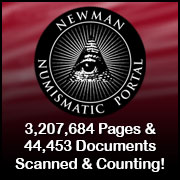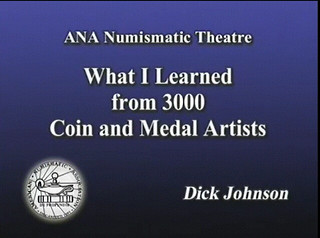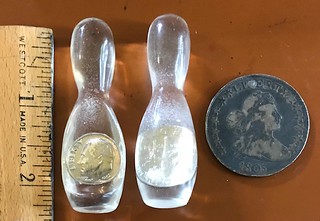
About UsThe Numismatic Bibliomania Society is a non-profit association devoted to the study and enjoyment of numismatic literature. For more information please see our web site at coinbooks.org SubscriptionsThose wishing to become new E-Sylum subscribers (or wishing to Unsubscribe) can go to the following web page link MembershipThere is a membership application available on the web site Membership Application To join, print the application and return it with your check to the address printed on the application. Print/Digital membership is $40 to addresses in the U.S., and $60 elsewhere. A digital-only membership is available for $25. For those without web access, write to: Charles Heck, Treasurer AsylumFor Asylum mailing address changes and other membership questions, contact Chuck at this email address: treasurer@coinbooks.org SubmissionsTo submit items for publication in The E-Sylum, write to the Editor at this address: whomren@gmail.com BUY THE BOOK BEFORE THE COINSale Calendar |
- WAYNE'S WORDS: THE E-SYLUM JANUARY 10, 2021
- KOLBE & FANNING BUY OR BID SALE NUMBER 14
- NEW BOOK: OFFICIAL INAUGURAL MEDALS
- NEW BOOK: AUSTRALIAN & NEW ZEALAND TOKEN VALUES
- NEW BOOK: ANTON MEYBUSCH MEDALLIST
- NEW BOOK: RADICAL HAMILTON
- SCRIPOPHILY DECEMBER 2020 ISSUE PUBLISHED
- DAVID C. KLINGER (1940-2020)
- DAVID FIERO (1950-2020)
- SYDNEY F. MARTIN NUMISMATIC PUBLICATION AWARD
- MCA HOSTS VIRTUAL MEETING WITH HEIDI WASTWEET
- 2021 NNP SYMPOSIUM ANNOUNCED
- NEWMAN PORTAL: THE 1894-S DIME IN 1896
- VIDEO: DICK JOHNSON LECTURE ON MEDAL ARTISTS
- MORE ON D. WAYNE JOHNSON
- SECOND PHILADELPHIA MINT IMAGE ORIGIN FOUND
- EITAN COHEN AND THE COHEN MINT
- MORE COIN PIE CRIMPERS
- NOTES FROM E-SYLUM READERS: JANUARY 10, 2021
- 1921 SILVER COIN ANNIVERSARY ACT BECOMES LAW
- HOBO NICKEL CAST COPIES FLOOD MARKET
- VOCABULARY TERM: COIN COLLECTING
- CHARLES WYLLYS BETTS (1845-1887)
- STEPHEN ALBUM RARE COINS AUCTION 39
- NUMISMATIC NUGGETS: JANUARY 10, 2021
- THE 1757 DASSIER 10-RUBLE COIN
- H. G. WELLS COMMEMORATIVE COIN CONTROVERSY
- ZERO CENTS NO-TIP KOOKIE KOIN
- COINS FOUND ON OUTER BANKS BEACHES
- COLLECTING BRICKS
- LOOSE CHANGE: JANUARY 10, 2021
- FEATURED WEB SITE: APOTHECARIES WEIGHTS
Click here to read the thin version on the web
Click here to subscribe
Click here to access the complete archive
To comment or submit articles, reply to whomren@gmail.com
Content presented in The E-Sylum is not necessarily researched or independently fact-checked, and views expressed do not necessarily represent those of the Numismatic Bibliomania Society.
WAYNE'S WORDS: THE E-SYLUM JANUARY 10, 2021
 New subscribers this week include: Jason Libby and Sean Wells, courtesy of Steve Olson; Maurice
Rosen, courtesy of Ron Guth; Lori Ferber, and Laurent Schmitt. Welcome aboard! We now have 6,605 subscribers.
New subscribers this week include: Jason Libby and Sean Wells, courtesy of Steve Olson; Maurice
Rosen, courtesy of Ron Guth; Lori Ferber, and Laurent Schmitt. Welcome aboard! We now have 6,605 subscribers.
Thank you for reading The E-Sylum. If you enjoy it, please send me the email addresses of friends you think may enjoy it as well and I'll send them a subscription. Contact me at whomren@gmail.com anytime regarding your subscription, or questions, comments or suggestions about our content.
This week we open with a numismatic literature sale, four new books, a periodical issue, a new publication award, updates from the Newman Numismatic Portal, and more.
Other topics this week include Inaugural medals, Australian & New Zealand tokens, the 1894-S dime, medal artists, coin pie crimpers, the 1921 Silver Dollar Coin Anniversary Act, Hobo Nickel fakes, C. Wyllys Betts, auction lots, the zero cents no-tip coin, and apothecary weights.
To learn more about Alexander Hamilton, responsible 'Minthood', medallist Heidi Wastweet, J. Oliver Amos, Dick Johnson, coins as machine parts, Teddy Roosevelt dimes, the Man in the Hairdo, the Syphilis medal, Kookie Koins, Mars coins, brick collectors and Basic Intergluteal Numismatics, read on. Have a great week, everyone!
Wayne Homren
Editor, The E-Sylum
KOLBE & FANNING BUY OR BID SALE NUMBER 14
Numismatic Booksellers Kolbe & Fanning submitted this announcement of their fourteenth "Buy or Bid Sale" which closes on January 21, 2021. Good luck, everyone! -Editor
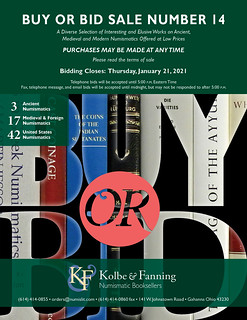 Kolbe & Fanning Numismatic Booksellers have announced our fourteenth "Buy or Bid Sale,"
which begins now and will close on Thursday, January 21, 2021. With hundreds of new additions, the sale focuses on modestly priced books, giving collectors an opportunity to add to their libraries at
minimal cost.
Kolbe & Fanning Numismatic Booksellers have announced our fourteenth "Buy or Bid Sale,"
which begins now and will close on Thursday, January 21, 2021. With hundreds of new additions, the sale focuses on modestly priced books, giving collectors an opportunity to add to their libraries at
minimal cost.
The sale includes over 1400 works on ancient, medieval and modern coins, as well as general works, periodicals and sale catalogues. "Buy" prices have been kept low to promote sales. To further encourage participation, the firm is offering free domestic shipping to bidders spending at least $300; there is also no packing and processing fee for this sale. Again, please read the Terms of Sale before participating.
As the name of the sale suggests, customers may bid on items they wish to acquire or buy them outright at the published price. The Terms of Sale will give full instructions on how to participate: please read it carefully.
There is no printed catalogue. The PDF catalogue is available now for downloading from the Kolbe & Fanning website at numislit.com. Please send all bids to orders@numislit.com or use the bid sheet included at the end of the PDF catalogue.
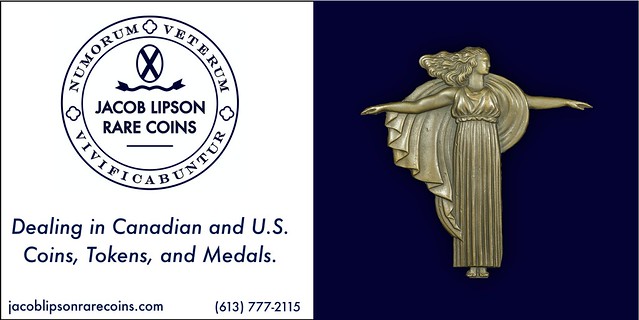
NEW BOOK: OFFICIAL INAUGURAL MEDALS
A new book by Matthew P. Chiarello on Inaugural Medals has just been published. -Editor
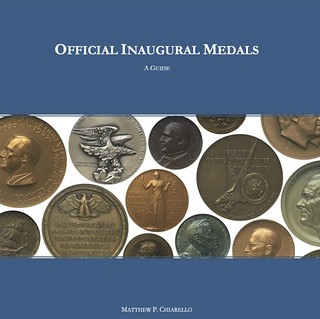 Official Inaugural Medals - A Guide
Official Inaugural Medals - A Guide
A complete handbook of official presidential and vice-presidential inaugural medals from William McKinley to Donald Trump. This numbered first edition of just 100 copies contains 76 full-color glossy pages, along with a mintage and price guide for identifying medals and tracking collections. The guide is an oversize hardcover, with large text and true-to-life images of the medals. Profusely illustrated and the first authoritative book on the subject that has been published in decades. New mint condition. Painstakingly written and photographed by Matthew P. Chiarello.
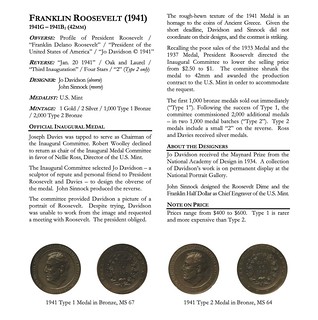
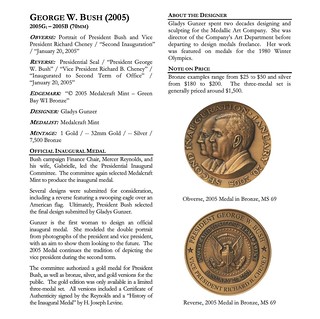
Due to the delays in USPS shipping recently, we will not be able to ship this book by USPS Media Mail. So instead it will be shipped either by Fed Ex Ground or USPS Priority Mail.
Price $50.00
Condition new
Product Condition Brand new
Size 10 1/8" x 10 1/8"
I understand they may be adding the USPS option back to the shipping choices sometime soon (if it's not there already), so watch for that change if you're interested in that option. -Editor
For more information, or to order, see:
JUST RELEASED - Official Inaugural Medals - A Guide (https://www.loriferber.com/official-inaugural-medals-book.html)
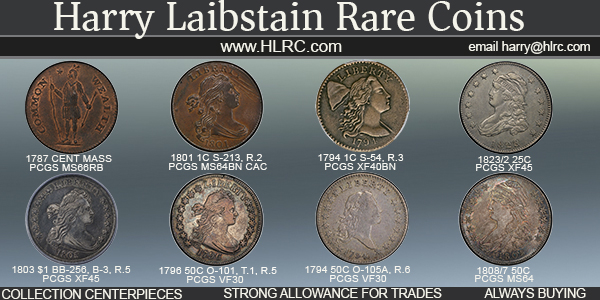
NEW BOOK: AUSTRALIAN & NEW ZEALAND TOKEN VALUES
Renniks has published a new book on Australian and New Zealand tokens. -Editor
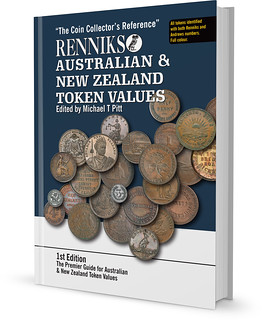 Renniks Australian & New Zealand Token Values
Renniks Australian & New Zealand Token Values
1st Edition
$39.95
Providing a sweeping overview of this important area of Australian numismatics, Renniks new Australian & New Zealand Tokens Values is simply a must-have for any token collector and anyone with an interest in Australian history. An impressive hardback publication, featuring a fantastic range of high quality photographs, the most important aspect of this vital reference is that the rarity AND the market values of every token have been completely revised.
For more information, or to order, see:
Renniks Australian & NZ Token Values 1st Edition
(https://renniks.com/shop/renniks-australian-nz-token-values-1st-ed/)
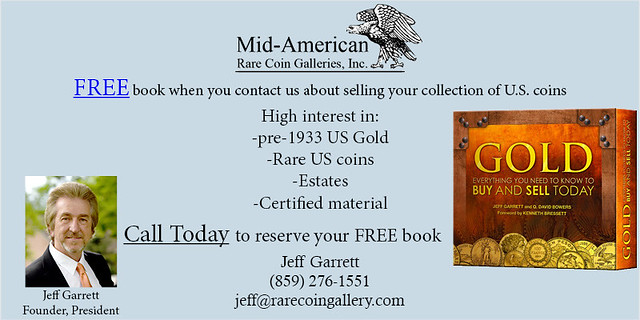
NEW BOOK: ANTON MEYBUSCH MEDALLIST
A CoinsWeekly review by Ursula Kampmann alerted me to a new book in Danish on the medallist Anton Meybush. Here's a Google-translated excerpt of an advertisement for it in the November issue of Meddelelser fra Dansk Numismatisk Forening. -Editor
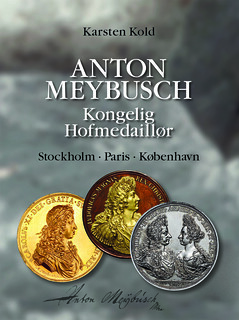 Karsten Kold writes about "Royal Court Medalist" Anton Meybusch's production of coins and
medals and employment conditions in Stockholm, Paris, Copenhagen, England and Germany. 320 pages - nice and richly illustrated.
Karsten Kold writes about "Royal Court Medalist" Anton Meybusch's production of coins and
medals and employment conditions in Stockholm, Paris, Copenhagen, England and Germany. 320 pages - nice and richly illustrated.
Price: DKK 375.
For members of DNF: 300 kr.
To read the complete issue (in Danish), see:
numismatisk rapport 147 (https://numismatik.dk/wp-content/uploads/2020/10/NR_147.pdf)
For more information, or to order, see:
https://numismatik.dk/litteratur/bestilling-af-litteratur/
To read the CoinsWeekly review, see:
The Medallist Anton Meybush (https://coinsweekly.com/the-medallist-anton-meybusch/)
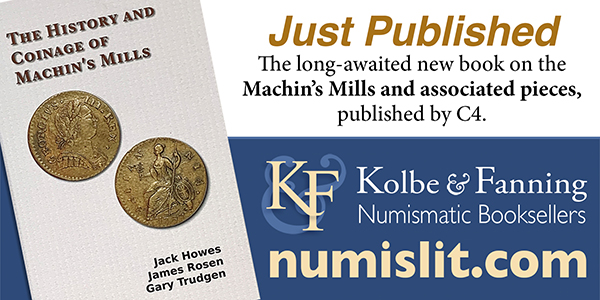
NEW BOOK: RADICAL HAMILTON
The Boston Review published an interview with Christian Parenti about his new book Radical Hamilton: Economic Lessons from a Misunderstood Founder. Alexander Hamilton was the first Secretary of the Treasury and created the country's modern financial system and central bank. -Editor
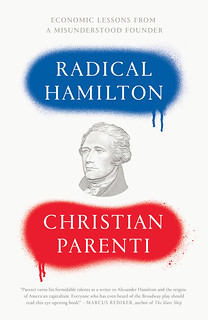 Christian Parenti: I wrote the book by mistake, because I stumbled upon Hamilton's often
name-checked but rarely discussed magnum opus, his 1791 Report on the Subject of Manufactures. At first the plan was to just republish the Report with an introduction. But that grew into this
book.
Christian Parenti: I wrote the book by mistake, because I stumbled upon Hamilton's often
name-checked but rarely discussed magnum opus, his 1791 Report on the Subject of Manufactures. At first the plan was to just republish the Report with an introduction. But that grew into this
book.
As I read up on the Report it became clear that there were major omissions and misunderstandings about Hamilton's political economy and its role in the course of U.S. economic development. Cast by most historians as the patron saint of free markets and financiers, Hamilton actually begins the Report with an attack on Adam Smith and laissez-faire economics. He then goes on to present a sweeping program of transformation-oriented economic planning. This is totally at odds with the mainstream story of American capitalism and Hamilton's place within it. Most books on Hamilton do not address Hamilton's vision of a planned economy.
Michael Busch: In the book, you argue that the Revolutionary War was formative for Hamilton, though not in the ways we have been led to understand. What was Hamilton's experience of the war, and how did it shape his political economic thinking?
Christian Parenti: Hamilton begins as a frontline officer, but after about a year and a half in combat he accepts a position on George Washington's staff. From that vantage point, Hamilton gets a broad overview of the conflict as a logistical, economic, and political process. He quickly sees how totally dysfunctional things are and that the central problem is a disunited and weak government.
The thirteen colonies have come together under the Articles of Confederation, a loose security pact, and Congress, the only national institution along with the Continental Army, does not even have the power to tax. It must request money from the states. The states do not always pay up. When they do, they sometimes try to direct resources exclusively to their own military units. For example, Pennsylvania sends cloth to Washington but asks him to distribute it only to the Pennsylvania line. In that example the shipment of cloth had already been looted by desperate citizens before it even reached Washington's command. In every aspect of the struggle there are major coordination problems and a dire lack of resources.
Amidst this, Hamilton gets a frontline education on the importance of national credit, economic coordination, and manufacturing capacity. And, he begins to sketch the outline of what Charles Tilly and later social scientists would call a "fiscal military state"—a government that can create economic conditions through borrowing, taxing, investing, and guiding the larger national economy toward growth, which, in turn, pays for the administrative and military capacities the state needs to defend its sovereignty internationally and against internal threats.
The Republics survival was not guaranteed by military victory, nor by experiments in democratic government alone. It required a profound economic transformation that took decades to achieve. And that economic transformation did not just occur naturally—it had to be produced by a sophisticated, innovative, and sweeping program of government action.
MB: It strikes me that the Hamiltonian theory of political economy in some ways anticipates Karl Polanyi's idea that the private sector is fundamentally dependent on government for its continued existence. In this light, your book understands the Constitution as a kind of toolkit for state-driven economy building. How does the Constitution do this—and in particular, how does it empower government to take economic action on behalf of the people?
CP: Most literature on the Constitution looks at how our government works: checks and balances, the three branches of government. I looked instead at what this government does. And in Article 1, Section 8, the Constitution reads as an outline for the developmentalist, or dirigiste, state.
There is a lot of seemingly prosaic and wonky stuff in Article 1, Section 8, so it is usually overlooked. But add it all up and you see a rudimentary but powerful policy toolbox for driving economic growth and transformation: taxing and spending, coining money, setting weights and measures, creating a post office and under its authority building transportation infrastructure, controlling bankruptcies, controlling intellectual property rights, regulating foreign trade and commerce between the states, controlling development of federal lands, building a navy and military, supporting scientific research, and serving "the General Welfare."
The Postal Clause empowers Congress to establish post offices and, crucially "post roads." Benjamin Franklin wanted an explicit mention of canals but was defeated. Yet that little word, "roads," meant that during the early nineteenth century the post office acted a huge public works agency—huge by the standards of that day. By 1830 it had built 115,000 miles of post roads, which is to say most of the country's major roads. And it cleared and made navigable all the major rivers. The post office plays an important role even into the twentieth century.
To read the complete article, see:
What We Still Get Wrong About Alexander Hamilton
(https://bostonreview.net/class-inequality-politics/christian-parenti-michael-busch-what-we-still-get-wrong-about-alexander)
For more information, or to order, see:
Radical Hamilton Economic Lessons from a Misunderstood Founder (https://www.versobooks.com/books/3186-radical-hamilton)
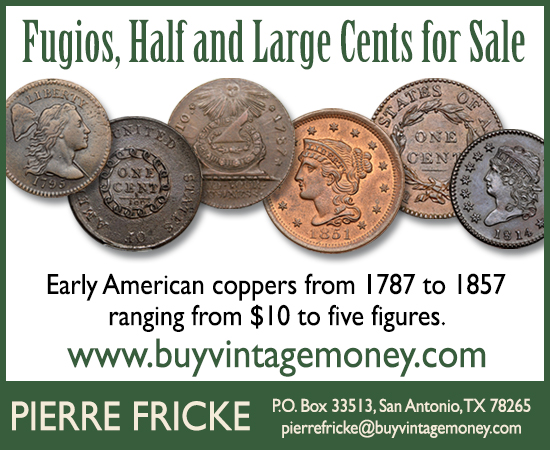
SCRIPOPHILY DECEMBER 2020 ISSUE PUBLISHED
Scripophily Editor Max Hensley submitted this information about the latest issue. Thank you! -Editor
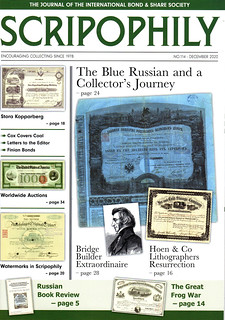 Here is the most recent Scripophily issue, 114th in a line, for December 2020. It is our
biggest one yet, 60 pages in print. All contributors and staff are volunteers with the International Bond & Share Society.
Here is the most recent Scripophily issue, 114th in a line, for December 2020. It is our
biggest one yet, 60 pages in print. All contributors and staff are volunteers with the International Bond & Share Society.
The main articles are about Fenian bonds, the Great Frog War of the Delaware and Bound Brook Railroad, Hoen and Co printers of Baltimore, scripophily watermarks, Russian railway bonds and shares, suspension bridges of Charles Ellet, Jr. and Swedish copper and iron mining. Also covered is news and an extensive auction report section.
Look at a past issue on-line at http://www.scripophily.org.
THE BOOK BAZARRE
DAVID C. KLINGER (1940-2020)
I was sorry to learn today of the passing of longtime E-Sylum contributor David Klinger. Thanks to Fred Schwan for announcing it in the MPC Gram. -Editor
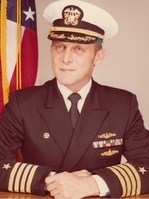 David Calvin Klinger, 80, of San Antonio, Texas, passed away on December 24, 2020. He was the
beloved husband of Marilyn (Nutt) Klinger and they enjoyed 56 years together in marriage.
David Calvin Klinger, 80, of San Antonio, Texas, passed away on December 24, 2020. He was the
beloved husband of Marilyn (Nutt) Klinger and they enjoyed 56 years together in marriage.
Born in Lykens, PA on January 25, 1940, Mr. Klinger spent his childhood years in Lykens before enrolling in Penn State University. After participating in the ROTC program and graduating with a degree in Engineering, Mr. Klinger began a distinguished 30-year career as a commissioned officer in the Submarine Service of the U.S. Navy. His initial service started in 1961 on the destroyers U.S.S. Norris and U.S.S. Agerholm, where he quickly rose through the ranks and was selected to complete Nuclear Power School training in California (where he met Marilyn). In 1965 he was deployed on the U.S.S. Francis Scott Key, a nuclear submarine based out of Groton, CT, followed by submarine assignments on the U.S.S. Seahorse (1968-71, Navigator) in Charleston, SC and the U.S.S. George C. Marshall (1973-77, Lt. Commander). From 1977-81 Mr. Klinger was Commander and Captain of the ballistic nuclear submarine U.S.S. Sam Houston based out of Pearl Harbor, HI and Bangor, WA.
Mr. Klinger's career continued as a Captain and Operations Officer at the U.S. Embassy in London, UK (1981-84), and in the War Gaming Department of the Naval War College in Newport, RI (1984-88). He was next appointed to Commanding Officer of the U.S. Navy Base in La Maddalena, Italy (1988-90) before finishing his naval career as Captain at the Center for Naval Warfare Studies at the Naval War College (1991).
Mr. Klinger spent his next 27 years of retirement in San Diego, CA, where he and Marilyn spent many years proudly hosting and entertaining visitors from all over the country and the world in their beautiful home overlooking San Diego Bay. He loved working on and improving his home, and took great pride in hosting annual visits from his children, grandchildren, and many relatives.
During his retirement, he continued his lifelong love of numismatics and contributed many articles to scholarly journals chronicling the origins of coins from around the world. He also completed 15 annual cross country treks in his modified camper van and to coin conventions where he was a respected authority and contributor.
To read the complete article, see:
David C. Klinger 1940 - 2020
(https://www.legacy.com/obituaries/newportri/obituary.aspx?n=david-c-klinger&pid=197401672)
To read a selection of David's earlier E-Sylum contributions, see:
OLDEST ARTICLE/SPEECH ON NUMISMATICS? (https://www.coinbooks.org/esylum_v05n49a10.html)
NEW CURRENCY FOR IRAQ (https://www.coinbooks.org/esylum_v06n15a04.html)
JAPANESE OCCUPATION PATTERN COIN AND BOOK (https://www.coinbooks.org/esylum_v09n16a04.html)
CHIPS, THE DOG WITH A PURPLE HEART (https://www.coinbooks.org/esylum_v13n29a16.html)
THE "RUB AND SNIFF" MARIJUANA COIN (https://www.coinbooks.org/esylum_v14n20a17.html)
BANK OF PORTUGAL 20 ESCUDOS BANKNOTE AND MEDAL (https://www.coinbooks.org/esylum_v15n30a12.html)
THE LONDON 2012 OLYMPIC MEDALS (https://www.coinbooks.org/esylum_v15n33a20.html)
INFLATION MONEY AND PROPOSED PLATINUM COIN DESIGNS (https://www.coinbooks.org/esylum_v16n02a23.html)
ELECTRONIC BENEFIT TRANSFER TOKENS (https://www.coinbooks.org/esylum_v16n10a16.html)
BASIC INTERGLUTEAL NUMISMATICS (https://www.coinbooks.org/esylum_v17n03a26.html)
THE NUMISMATICS OF GOLF (https://www.coinbooks.org/v21/esylum_v21n14a27.html)

DAVID FIERO (1950-2020)
Dale Seppa submitted this remembrance of numismatist David Brian Fiero. Thanks. -Editor
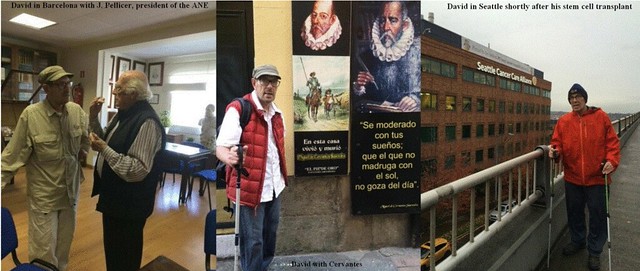
David Fiero, PhD, numismatist, author, teacher and friend passed away on December 28, 2020 at 11:20 am. His five-year-long ordeal with Multiple Myeloma and Bladder Cancer finally came to an end. David was 70 years old and despite a successful stem cell transplant at the Fred Hutchinson Cancer Research Center in 2015 his final years were marked by chronic pain.
He met his wife Petra when she was nineteen, on her very first day at the University of Regensburg; the two were linked for nearly forty years by their dedication to educating students of English, Spanish, and German at the University of Nebraska-Lincoln and Western Washington University in Bellingham. David had inspired her and many of his other students to study abroad.
David pursued his hobby of collecting coins with extraordinary passion. He earned his PhD in Modern Languages and Literatures (Spanish) from the University of Nebraska-Lincoln in 1997 with his dissertation Don Quijote: A Numismatic and Economic Analysis --Literary Images of Coinage, Wealth and Poverty. He was ideally suited to write about this topic since he was able to combine his love of literature with his tremendous knowledge of the economic circumstances and coinage of the Golden Age in Spain. During the last five years he rewrote his thesis under the title Tilting at a Numismatic Windmill: The World of Don Quixote in Coins, Medals, Tokens and Banknotes. Much of his time in retirement was spent acquiring and inserting photographs of the precious coins he was writing about in that work.
I often sought David's advice and in particular took advantage of his Spanish to English translating skills when I encountered archaic or highly technical sections that were simply beyond my ability to confidently translate. His book reviews were legion and a simple search on the Newman Numismatic Portal reveals more than a dozen articles and book reviews, and this list is far from complete.
Because of my personal interests his introduction to Michael Anderson's book A Numismatic History of Ecuador was one of my favorites. It was entitled "Eyes Open, Ears Wide Shut: Ecuador's Struggle in the Nineteenth Century. Responsible 'Minthood' or Quixotic 'Enchantment'". It was subsequently republished as a stand-alone article in World Coin News. In only ten pages David was able to cogently synthesize the history of the Quito Mint, the overall monetary situation and many of the political factors involved in Ecuador's monetary history.
Brent Carbajal, the Provost of Western Washington University in Bellingham, said the following in a letter of condolence to Petra: "I think I am perhaps better positioned than anyone to describe David's numismatic knowledge and love of coins. I think you know it to be true of me that I'm not given to exaggeration or effusive emotion. From there, I will offer that there has never been and will never be anyone who loves coins more than David. David was an authentic numismatist, yes! He was also a true coin collector and didn't resent that title. I have read many books and talked to many people about coins. I don't expect to ever meet anyone more knowledgeable about coins and their role in history than David. I learned so much from David and actually acquired a life-long passion for coins myself, feeling privileged to have learned from the best. I will forever cherish our trips to coin shows together and will never forget his teachings. In fact, coins will simply always remind me of David."
David was a voracious reader to the last day of his life. He studied the newspaper every day from beginning to end and would watch the PBS News Hour every night to know what was going on in the world. He read books in English, Spanish or German on a variety of subjects. He was intrigued by stories of explorers of the wild regions of the world, by history books, great literature on any subject and kept increasing his knowledge of the world that way.
Other aspects of David's were his love for the wilds of the Northwest, his walking and swimming endurance, and his nearly professional bicycling ability. He was also an accomplished guitarist and founded the duo "The Primitives" with Kendall Whitney. He is missed by his wife, my wife, me, many numismatists, as well as dozens of his close friends and associates. He will be mourned by many but never forgotten.
To read Fiero's online obituary, see:
David Brian Fiero 1950 - 2020
(https://www.legacy.com/obituaries/bellinghamherald/obituary.aspx?n=david-brian-fiero&pid=197444087)

SYDNEY F. MARTIN NUMISMATIC PUBLICATION AWARD
The Colonial Coin Collectors Club has created a new award for numismatic publications. Syd is a member of the NBS Board of Governors and the author of multiple award-winning books on U.S. colonial coinage. -Editor

The Sydney F. Martin Numismatic Publication Award
The C4 Board of Directors is pleased to announce creation of the Sydney F. Martin Numismatic Publication Award.
This award joins the Eric P. Newman Memorial Lectureship Series presentations and the Q. David Bowers Award for Excellence in Numismatic Research in recognizing the work of individuals for their contributions to the field of Colonial and Early US coinages.
This award will be presented to authors of books published through C4, and at the Boards discretion can also be presented to authors of works published outside of C4.
The primary purpose of the award will be to recognize the work and its contribution to the dissemination of numismatic knowledge of Colonial and Early US numismatics.
Your Board hopes this award, in some small way, recognizes and honors Syd's outstanding contributions via his four published books, all of which have become the standard references on their respective series, many of which previously lacked a concise and recognized standard reference.
Please join us in recognizing Syd for his outstanding contributions which form the foundation for creation of this award.
For more information on the Colonial Coin Collectors Club, see:
https://colonialcoins.org/
MCA HOSTS VIRTUAL MEETING WITH HEIDI WASTWEET
The Medal Collectors of America is inviting everyone to their next virtual meeting, where sculptor, medallist, past president of the American Medallic Sculpture Association and former Citizen Coinage Advisory Committee member Heidi Wastweet will speak. -Editor
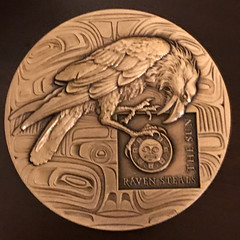
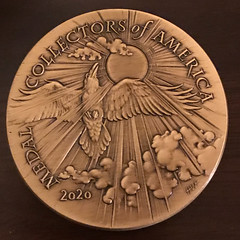
We would like to inform your readers that we have 45 spots available for this month's Medal Collectors of America virtual meeting. We are hosting guest speaker Heidi Wastweet, a leading American Medallist and sculptor working in the San Francisco Bay area. The spots are available on a first come, first served basis for anyone who would like to attend. The particulars are:
When: MCA meeting Saturday, January 23 via ZOOM
Time: 1 PM EST (12:00 PM noon CST & 10:00 AM PST)
Speaker: Heidi Wastweet, "Old Well, New Water; Drawing Modern Inspirations from Classic Medals"
RSVP: email Anne Bentley at numismatist9@gmail.com We will send the Zoom link several days prior to the meeting.
I have to say that I'm looking forward to hearing her speak. She designed our 2020 club medal, which is exquisite, and I've enjoyed seeing more of her work on her website.
For more information on Heidi and her work, see:
https://www.wastweetstudio.com/
For more information on the Medal Collectors of America, see:
https://www.medalcollectors.org/
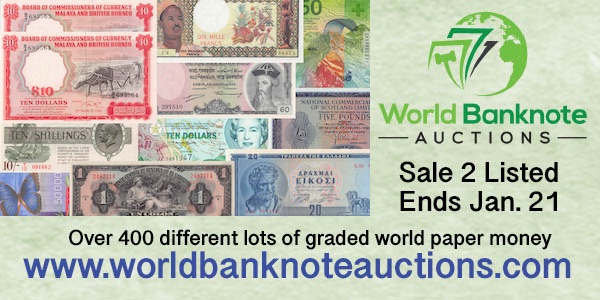
2021 NNP SYMPOSIUM ANNOUNCED
The first NNP Symposium was a great success. The second event has just been announced. Be sure to register now for future updates. -Editor
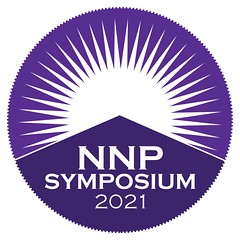 Launched in August 2020, the Newman Numismatic Portal (NNP) Symposium brings together a diverse
selection of numismatic presentations into a concentrated, three-day, Zoom-based format. The first event, held August 28-30, 2020, featured talks on a variety of topics including U.S. federal
coinage, tokens and medals, paper money, and ancient and world numismatics. The complete set of over forty presentations from the August 2020 Symposium, produced by Lianna Spurrier of Numismatic
Marketing, is available for viewing at https://nnp.wustl.edu/library/multimediadetail/539070.
Launched in August 2020, the Newman Numismatic Portal (NNP) Symposium brings together a diverse
selection of numismatic presentations into a concentrated, three-day, Zoom-based format. The first event, held August 28-30, 2020, featured talks on a variety of topics including U.S. federal
coinage, tokens and medals, paper money, and ancient and world numismatics. The complete set of over forty presentations from the August 2020 Symposium, produced by Lianna Spurrier of Numismatic
Marketing, is available for viewing at https://nnp.wustl.edu/library/multimediadetail/539070.
Newman Portal is pleased to announce the second NNP Symposium, which will take place via Zoom on March 19-21, 2021. As large-scale numismatic conventions continue to be cancelled, this event will provide a virtual "fix" of numismatic content and allow collectors to view programs on any number of topics, or to present on their own favorite subjects. Comments received by attendees after the first event included, "These last three days were the closest I've come to having a coin convention experience since before the coronavirus hit," and, "It got the coin collecting juices flowing again for those of us hunkered down waiting for the next show."
The NNP Symposium invites individual presenters and numismatic organizations to register for a Symposium meeting slot. Any presentation inquiries may be submitted via https://nnpsymposium.org/for-presenters. Dealers are welcome to participate and might use this time to introduce their business or present selected inventory highlights. The NNP Symposium staff will ensure smooth delivery of all content by moderating each session and providing Zoom training to attendees and presenters prior to the event.
A sampling of committed speakers as of press time includes:
Garrett Ziss: Ziss, the 2020 American Numismatic Association Young Numismatist of the Year, will present "From the War of 1812 to the Civil War: A Chronology of a Numismatic Marriage."
Sarah Miller: "A Day at Heritage Auctions' New York Office" will provide an insider view of this auction company, from the Director of Numismatics at the Heritage Auctions location in New York.
Chris McDowell: McDowell, editor of the Journal of Early American Numismatics, will speak on new discoveries in the Betts medal series.
Beth Deisher: This long time Coin World editor will discuss the impact of Chinese counterfeits on the U.S. numismatic market.
Daryl Haynor: Winner of the Numismatic Literary Guild Book of the Year award, Haynor will provide an overview of his book United States Classic Gold 1834-1839.
A full list of speakers, updated frequently, is available at https://nnpsymposium.org/schedule. NNP Symposium attendees should register at https://nnpsymposium.org/register and will receive periodic updates including overall schedule and meeting links. Symposium registration is free, in keeping with the NNP philosophy of providing numismatic information on a free-and-forever basis.

NEWMAN PORTAL: THE 1894-S DIME IN 1896
The latest addition to the Newman Numismatic Portal is an 1896 letter from a woman asking about the 1894-S dime. Project Coordinator Len Augsburger provided the following report. Thanks. -Editor
The 1894-S Dime in 1896
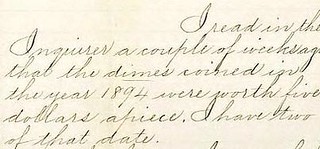 Recently transcribed by Newman Portal is a letter written by Philadelphia resident Anna Clark
to the U.S. Mint Director in 1896, asking about the collector value of 1894 dimes. Although brief, the letter reveals a number of things regarding the state of collecting in the late 19th century.
First, there were no ubiquitous references that might have been known to the letter writer. Today, Guide Book has filled that role for nearly 75 years, not to mention the explosion of other
references on the Internet.
Recently transcribed by Newman Portal is a letter written by Philadelphia resident Anna Clark
to the U.S. Mint Director in 1896, asking about the collector value of 1894 dimes. Although brief, the letter reveals a number of things regarding the state of collecting in the late 19th century.
First, there were no ubiquitous references that might have been known to the letter writer. Today, Guide Book has filled that role for nearly 75 years, not to mention the explosion of other
references on the Internet.
The letter writer was also apparently unaware that local dealers would be a source of ready and accurate information (the Chapman brothers in Philadelphia were well established by this time), and instead applies directly to the Mint Director to answer her query. Finally, the nature of the query suggests there was already some public consciousness regarding the 1894-S dime and its potential value. The all-important detail of the mintmark was lost in translation, not surprising in the era before millions of coin boards served to educate the general public about coin collecting.
Image: Letter from Anna Clark, Philadelphia resident, asking about the value of 1894 dimes
Link to Anna Clark letter related to 1894 dimes on Internet Archive:
https://archive.org/details/are1894dimesworth5doleach18960109/page/n1/mode/2up
Link to National Archives content on Newman Portal:
https://nnp.wustl.edu/Library/Archives?searchLetter=U

VIDEO: DICK JOHNSON LECTURE ON MEDAL ARTISTS
These are selections from the David Lisot Video Library that feature news and personalities from the world of coin collecting. David has been attending coin conventions since 1972 and began
videotaping in 1985. The Newman Numismatic Portal now lists all David's videos on their website at:
https://nnp.wustl.edu/library/multimediadetail/522852
Here's a recorded lecture by the late Dick Johnson. -Editor
What I Learned from 3000 Coin and Medal Artists
Speaker: Richard Wayne "Dick" Johnson
The creation of coins and medals spanning 350 years in America has taught the speaker the importance of changing technology in the field. For 200 years it was the hand engraver, but since 1900 it is the sculptor who creates these objects we collect. In this lecture-only video you will learn about:
- The technology changes that have influenced medal production
- How Victor David Brenner was pivotal in these changes
- America's first coin struck in 1652
- Different kinds of engravers
- History of U.S. Mint engravers and the coin presses used
- Europe's engraving technology and how it was brought back to America
- Early American engraving firms
- How the Civil War was a boom time for engravers
- The Columbian Exposition and the plethora of coins and medals produced
- Conclusions about engraving in general
A book has been written that complements the information in this video. Videotaped at the American Numismatic Association Convention in 2002.
To watch the video on NNP
https://nnp.wustl.edu/library/book/557085
MORE ON D. WAYNE JOHNSON
The previous article in this issue links to a videotaped lecture on medal artists by Richard Wayne "Dick" Johnson, who passed away last week. Here is some more information about his life -Editor
MCA Oral History Project
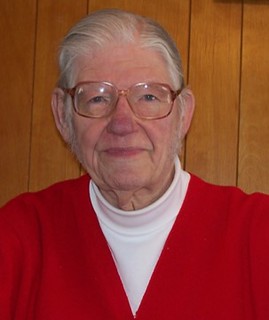 Len Augsburger writes:
Len Augsburger writes:
"In addition to the Dick Johnson video produced by David Lisot, the Medal Collectors of America conducted a series of oral history recordings in 2008-2009, two of which feature Johnson. John Sallay interviewed Johnson, August 30, 2009, in two segments, while Johnson in turn interviewed Princeton curator Alan Stahl on November 19, 2008. The Stahl interview is presented in four sessions."
To listen to the interviews, see:
Oral History of Medallic Art (https://www.medalcollectors.org/multimedia/audio)
Coin World Corrections
Former Coin World Editor Beth Deisher noted a couple of errors in Dick's recollections as told to Pete Smith. Thanks! -Editor
Beth writes:
"Dicks dispute over compensation was with J. Oliver Amos, not John Amos. J. Oliver Amos was president of Sidney Publishing Co. and the founding publisher of Coin World. He hired Dick and the disagreement was between the two of them. John Amos, J. Oliver's son, was not in Sidney when Coin World was founded. He was living and working in California. When J. Oliver retired in the mid 1970s, John became publisher of both the Sidney Daily News and Coin World.
"Margo Russell was not related to the Amos family. Margo, while still in high school, wrote a number of articles that were published in the Sidney Daily News. Upon graduation she was hired as a reporter for the daily newspaper and would meet Marion Russell, also a staff member of the Sidney Daily News. After the Pearl Harbor bombing, most of the men on the SDN staff either volunteered or were drafted into the military, including Marion. Margo and several other women kept the SDN in business during the war. Margo once told me she did everything from writing and editing to delivering the SDN during the war years.
"When Marion returned from military service at the end of the war, he and Margo were married and Margo "retired" home to begin a family. When J. Oliver started Coin World in 1960, he contacted Margo to see if she would work from home as a researcher/writer for the new publication. (Marion was still on the SDN staff.) She began writing for Coin World and learning about coins. When Johnson left CW, Margo became a full-time staff member at Coin World and worked alongside J. Oliver for two years before being named editor.
"I did an interview with J. Oliver in 1985 (for a special insert celebrating CW's 25th anniversary) and he related that after Johnson left, he spent two years interviewing people from across the country to find a new editor. He said he finally realized the person he was looking for was Margo and he offered her the job. He said hiring Margo as editor of CW was one of the best decisions he ever made."
The Belskie Museum Meeting
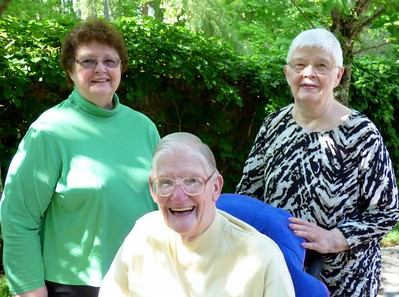
Beth also noted that my caption on the above photo of her with Dick and Shirley Johnson was incorrect. It was taken at a 2015 meeting related to the Belskie Museum, but was not held AT the museum. Rather, it was held at the home of Andrea Jovine in Greenwich, CT. where Dick had arranged for Trustees of the Belskie Museum to accept a donation made by members of the DiLorenzo family of medals by Joseph DiLorenzo.
Here are some additional photos of the meeting, showing Dick completely in his element, handling and researching medals. -Editor
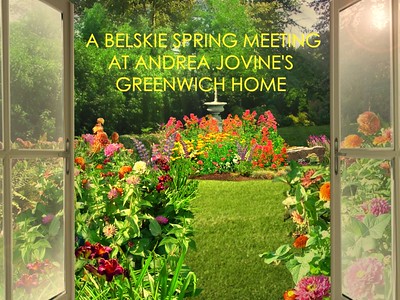
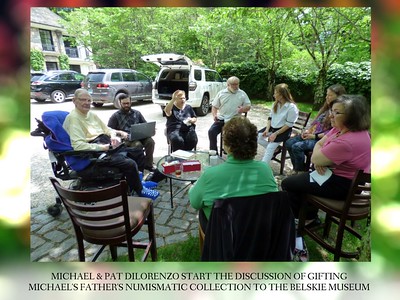
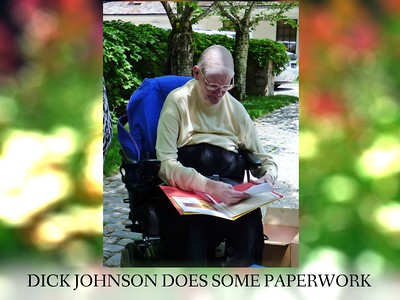
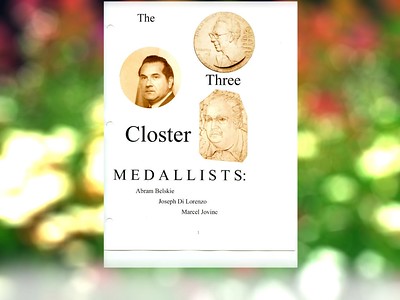
To see the complete photo gallery:
"A Belski Spring Meeting at Andrea Jovine's Greenwich Home"
(http://play.smilebox.com/SpreadMoreHappy/
4e4449314e5467314d4442384e7a59784d6a41354d446b3d0d0a)
Scott Miller writes:
"I was sorry to hear of Dick Johnson's passing. As a young collector I sat through many of his auctions, and fondly recall one of the great draws being coffee and donuts served during the break, necessary to get us through the marathon sales."
To read the earlier E-Sylum articles, see:
D. WAYNE JOHNSON (1930-2020) (https://www.coinbooks.org/v24/esylum_v24n01a06.html)
RECOLLECTIONS OF D. WAYNE JOHNSON (https://www.coinbooks.org/v24/esylum_v24n01a18.html)
A DICK JOHNSON E-SYLUM SAMPLER (https://www.coinbooks.org/v24/esylum_v24n01a19.html)
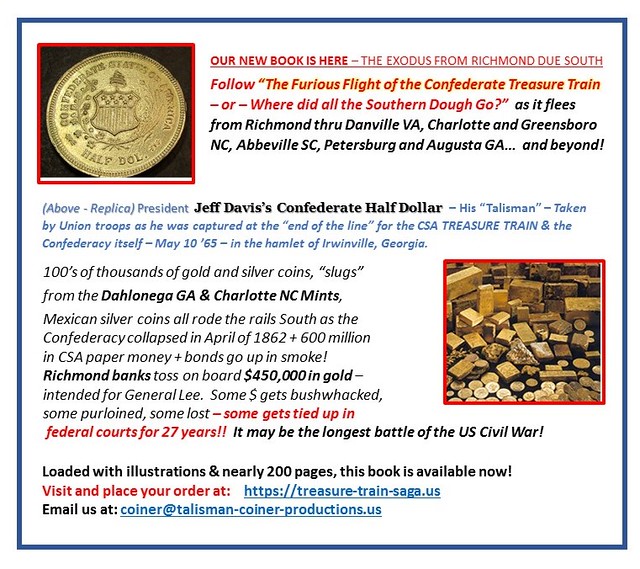
SECOND PHILADELPHIA MINT IMAGE ORIGIN FOUND
Readers have new responses on the image of the Second Philadelphia Mint that Pete Smith discovered. Thanks! -Editor
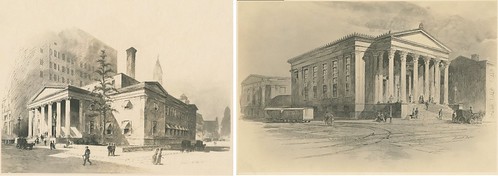
LEFT: Second U.S. Mint; RIGHT: 7th Presbyterian Church
Ross Johnson of New Hope, PA writes:
"While I can't identify the source of the above image in question, a quick search on the internet revealed the following similar view. Please note that in this alternative 1881 image by Benjamin Evans, the Mint building at left has the requisite six column facade. Perhaps the undocumented image reflects some artistic license on the part of the artist? The Mint, after all, was not the focus of either drawing. Then again, in the Evans drawing apparently there are four columns of windows on the left face of the church, vs. five on the unattributed view?! Obviously these are two views of the same location, but these differences are challenging to interpret. Did the artists draw what they saw?...or is this evidence of nineteenth century "photoshopping"?"
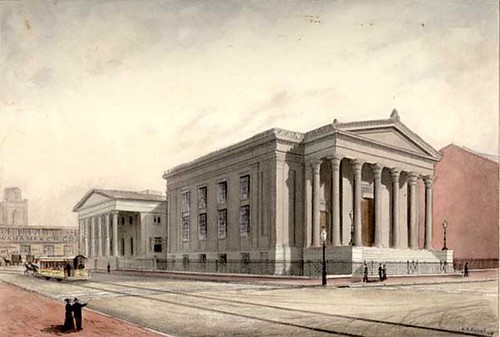
Benjamin R. Evans. Southeast corner of Broad Street and South Penn Square, 1881. Pen-and-ink and watercolor on paper.
Ross adds:
"... the Mint ... appears in this 1881 Evans watercolor of the Seventh Presbyterian Church, known as Rev. Lord's Church, located below Southeast Penn Square..."
To read the complete article, see:
Philadelphia in Watercolor (http://librarycompany.org/mirrorofacity/section8.htm)
Len Augsburger writes:
"The second Mint image was drawn by Frank H. Taylor, who did a whole series of Philadelphia street scenes c. 1900. There is a large (complete?) collection of these in the Free Library of Philadelphia. I don't believe they were published at the time of creation but were available on a subscription basis. See Secret History for more on Taylor."
Pete's question was fueled by his discovery of the two images at the Free Library of Philadelphia. Now we know the artist. Len referenced The Secret History of the First U. S. Mint. , the book he co-authored in 2011 with Joel Orosz. -Editor
To read the earlier E-Sylum articles, see:
QUERY: SECOND PHILADELPHIA MINT IMAGE ORIGIN (https://www.coinbooks.org/v23/esylum_v23n50a13.html)
SECOND PHILADELPHIA MINT IMAGE QUESTION (https://www.coinbooks.org/v24/esylum_v24n01a09.html)
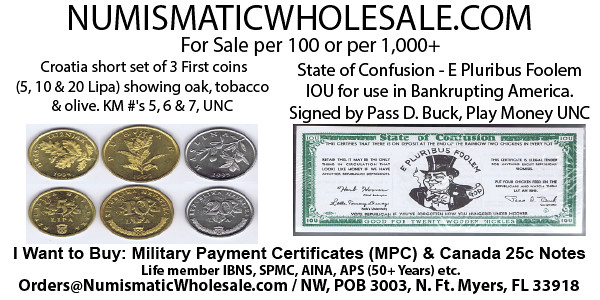
EITAN COHEN AND THE COHEN MINT
Gabriel Kahan is the eldest son of Eitan Cohen of the Cohen Mint. He found our earlier E-Sylum articles on the web. -Editor
Gabriel writes:
"Over the past few years, I have scoured the web for people still showing interest in my dad's work and it warms my heart that people are still curious about him. While I have not continued his mint, seeing his mark in the rare metals industry continue to be discussed after nearly a decade since he passed is incredible."
Gabriel kindly pulled together the following submission about his father and his mint. Thank you! It's great to make a connection like this and clarify information. -Editor
My father, Eitan Cohen, was born in Israel, in July of 1980, to parents of unknown descent (though we believe they were from Estonia and moved to Israel, where they had him). Only a few years after he was born, they moved to Brooklyn, New York, where he would grow up.
Eitan was extremely fond of rare coins as a child - having his own collection - and would regularly shop at antique stores hoping to find more. It is very likely from this childhood love of currency that he decided to mint his own. Strangely enough, we are not entirely sure where he acquired the knowledge on how to mint in the first place; He never attended a post-secondary or trade school. If I had to guess, he may have simply read books on the process or seen online manuals/guides, and taken it from there. He was very crafty, having built his own guitar and amp from bare materials, so I would not exclude this from the realm of possibility.
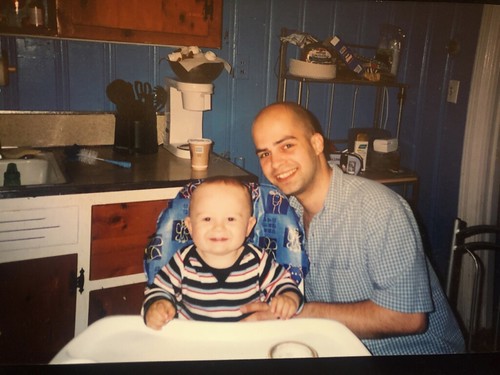
Eitan with his son Gabriel in the early 2000s
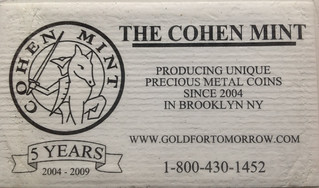 As for the business itself, Eitan worked completely alone. I noticed on several websites that
claimed to have pictures of the business, it shows some sort of concrete bunker. That is amusingly not the case, and the idea of such a massive bunker in the middle of Brooklyn is quite silly.
Rather, he worked entirely out of our apartment, in his workroom and sent orders by hand through our local post office, receiving mail from a nearby PO box. I can assure you it was no bunker. The
specifics of his work are lost to me, but he seemed to be using a small gas furnace to melt down metals to use in various molds, and hand-cranking a press to get a design. Again, all done by himself
in our apartment.
As for the business itself, Eitan worked completely alone. I noticed on several websites that
claimed to have pictures of the business, it shows some sort of concrete bunker. That is amusingly not the case, and the idea of such a massive bunker in the middle of Brooklyn is quite silly.
Rather, he worked entirely out of our apartment, in his workroom and sent orders by hand through our local post office, receiving mail from a nearby PO box. I can assure you it was no bunker. The
specifics of his work are lost to me, but he seemed to be using a small gas furnace to melt down metals to use in various molds, and hand-cranking a press to get a design. Again, all done by himself
in our apartment.
I am unsure of when it exactly began, but my father suffered from pancreatic cancer for many years. It was likely after 2009 that his work began to slow, and by 2010-11 he was too sick to fulfill most of his orders. Though some still were completed, many customers were left with the impression that the business was a scam. They were unfortunately left in the dark about his health issues.
My father ultimately passed in August of 2012, though from sepsis that was caused by surgery, and not the cancer itself.
The design commonly seen on his work (the man riding the horse) has no major significance, and was likely just a design he wanted to stick with. He sketched quite a lot, although any notebooks containing these sketches are lost.
Nearly all business-related items (his machines, notebooks, etc.) are gone. Due to financial troubles a while after he passed, we had to move out of the apartment very quickly, which meant having no time to properly move his equipment or personal items. All that really remains are pictures of him and personal belongings.
Thank you for covering my father's work.
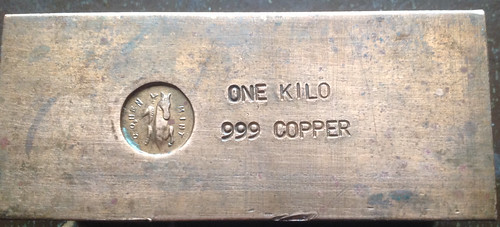
To read the earlier E-Sylum articles, see:
NOTES FROM E-SYLUM READERS: OCTOBER 25, 2020 : Query: The Cohen Mint (https://www.coinbooks.org/v23/esylum_v23n43a12.html)
NOTES FROM E-SYLUM READERS: NOVEMBER 29, 2020 : More on The Cohen Mint (https://www.coinbooks.org/v23/esylum_v23n48a13.html)

MORE COIN PIE CRIMPERS
It's amazing what E-Sylum readers collect. Here are some follow-ups on last week's item about the Large Cent pie crimper. -Editor
Carol's Coin Pie Crimpers
Carol Bastable writes:
"I have a few coin pie crimpers in my collection. One is a U.S. large cent and the other two are on foreign coins. Seeing the edge on the crimpers is really interesting. It would be quite a bit of work to make. To get the zig zag wider, two coins were sandwiched together on the large cent one."
Wow - small world! Thanks. Carol sent images of two of them. Neat. -Editor
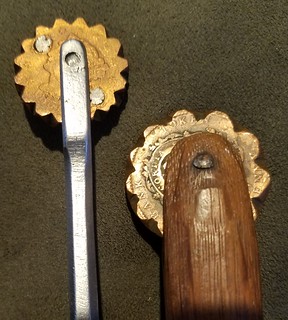
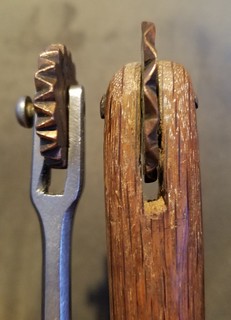
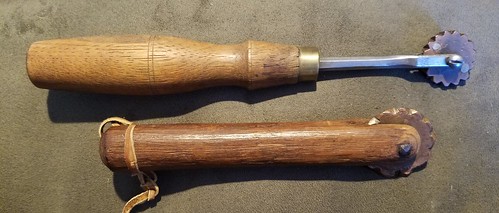
Antler Coin Pie Crimper
Carol also found this eBay listing for a pie crimper made from a coin and a DEER ANTLER! -Editor
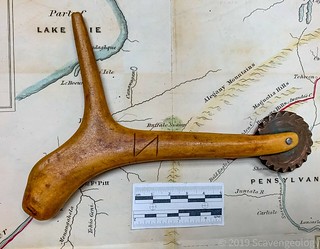
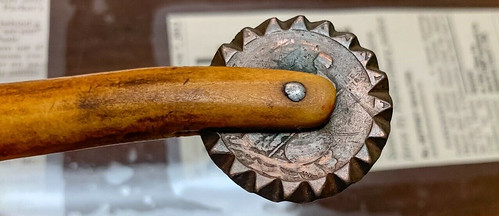
This is an awesome antique "pie crimper," also called a "Jagger Wheel," which is probably the coolest pie crimper ever made. Some have theorized that a frontiersman-type husband made this for his wife. Or maybe he was just a guy who also liked to cook. Or possibly a crafty and talented woman. They were used to cut and slice dough, just generally. It's made out of a deer antler, and uses a thick, early British coin as the crimping wheel. The coin is a massive British 1797 Cartwheel Penny as the wheel. You can still see the "G" on the border of one of the filed edges. The antler is also personalized with what looks like a backwards N. These were used like a pizza cutter with a serrated edge, to cut flour dough. They were mostly used to cut small strips to design a latticework on top of a pie. It's possible also that the lower antler time was used to poke holes in a pie to ventilate it.
To read the complete lot description, see:
Deer Antler Copper Coin Jagger Wheel / Pie Crimper
(https://www.ebay.com/itm/Deer-Antler-Copper-Coin-Jagger-Wheel-Pie-Crimper-/303795898987)
Large Cent Pie Crimper Maker Counterstamp
Bob Merchant writes:
"Thanks for highlighting two of my eBay counterstamps in The E-Sylum. I also noticed the large cent pie crimper that you highlighted. In an amazing coincidence, one of my counterstamps this week (currently on eBay) is also made into a pie crimper, and it is counter-stamped by the company that (probably) made it!"
Very cool! Here's the lot image and description. -Editor
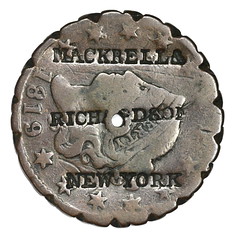
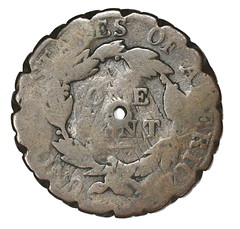
1819 U.S. Large Cent, holed in center
Countermarked "MACKRELL & / RICHARDSON / NEW YORK"
Coin has been made into a dough (or pie crust) cutter/crimper.
This business partnership was listed as a "manufacturer of cast bolts, shutter hinges, locks, etc". They also made kitchen tools. It is possible that the coin was countermarked by M&R and then also made into a kitchen tool by them.
Date of issue: 1839-1859.
Place of issue: New York City.
Brunk M-74.
Rulau M NY 2112.
Carol asked Bob to take pictures of the edge of his coin. Nice! That took a lot of work. -Editor
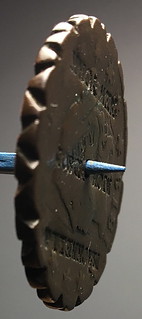

Coins as Machine Parts
Ken Spindler writes:
"I have a collection of about 60 heavily-worn French Revolution copper coins and tokens that were turned into some sorts of machine parts. Almost none of them have axis holes. Almost every one is different in some way from all of the others. I've exhibited them a few times and solicited knowledgeable advice about how the heck they may have been used, and received no reactions, even when they were out at the very large all-summer county fair, here in San Diego (Del Mar racetrack).
"Of course I'm aware that old large worn coppers from other countries shared the same fate. I probably own a very few of those, too, including U.S. I've got some perfectly-shaped gears with endless metallic circular friction marks on them. Yet no axis hole. I did recently see for sale another such pie crimper incorporating a coin, far cruder than this one, of wood with a rusty nail axis."
Thanks, everyone.-Editor
To read the complete lot description, see:
1819 U.S. Large Cent, Counterstamp "MACKRELL & / RICHARDSON / NEW YORK"
(https://www.ebay.com/itm/1819-U-S-Large-Cent-Counterstamp-MACKRELL-RICHARDSON-NEW-YORK/133619569670)
To read the earlier E-Sylum article, see:
NUMISMATIC NUGGETS: JANUARY 3, 2020 (https://www.coinbooks.org/v24/esylum_v24n01a23.html)
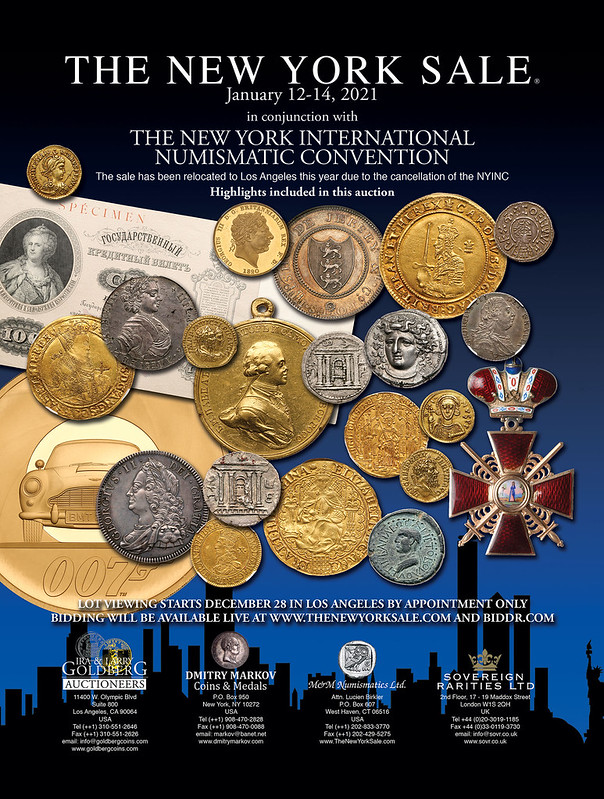
NOTES FROM E-SYLUM READERS: JANUARY 10, 2021
Author Fernando Chao Has Passed
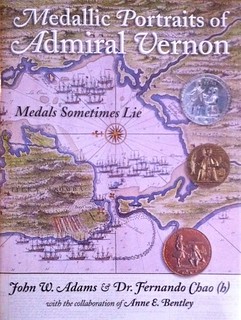 John W. Adams writes:
John W. Adams writes:
"It is my sad task to report that Fernando Chao has passed away, having fallen into the grips of Covid-19. Fernando was the author of many titles having to do with Latin American numismatics and, of course, he joined with me to write "The Medallic Portraits of Admiral Vernon". As important as were his contributions to numismatics, even more impressive was Fernando Chao, the man. I hope to write an extensive piece on this subject for the next issue of "The Advisory"."
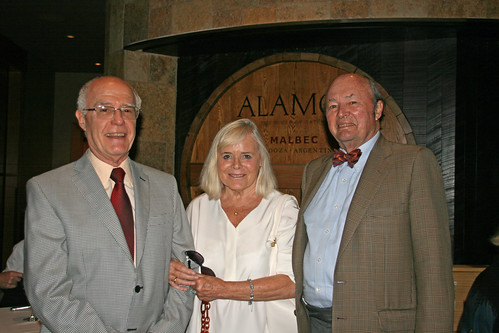
Fernando Chao with Regina and John W. Adams in 2016
Sorry to hear this news. We'll look forward to John's article in the official publication of the Medal Collectors of America (MCA). -Editor
2020: A Great Year For New Books
Darryl Atchison writes:
"2020 has been a year of both highs and lows numismatically speaking as evidenced by last week's issue. We've lost a number of numismatic giants over the past year (who will all be sorely missed by their friends in the numismatic fraternity) but I cannot help but marvel at the number of new books that are being published. Perhaps this is a positive result of the Covid lockdowns which has enabled numismatic authors to (finally) finish working on their various titles. Or maybe it's just a coincidence. Either way, the sheer volume of new books published over the past year is nothing less than staggering.
Looks like we'll all have to save a few pennies if we want to add even a fraction of these books to our libraries."
I haven't been counting, but it's quite true that a great number of books have been published over the last year. It would be hard to find a single week of The E-Sylum when we didn't have an announcement for at least one new book or edition. A great time to be a numismatic bibliophile. Anecdotally, one author told me this week that "I am attacking the enforced inactivity by starting a new book." -Editor
ANA Trivia Question: First Vice President 1899-1901
Pete Smith writes:
"The August 1891 issue of Plain Talk included a list of 25 people who may be considered the founding members of the American Numismatic Association. William G. Jerrems was listed as President with Joseph Hooper listed as Vice President. In 1899 Hooper advanced to the presidency with someone new filling the role of First Vice President.
Who was the person who served as First Vice President for the ANA during 1899-1901?
Next week I will give my answer and explain why I ask the question."
Good question. It's interesting to learn about the people who came together to form these first national organizations. Who's got the answer? -Editor
Roosevelt Dime Correction
Nick Graver writes:
"In the January 3rd issue Michael Merrill shows Duckpin shape coin holders. He mentions "Jefferson Dimes."
Oops! How'd we miss that? Sorry - we'll correct our archive to reflect that these are of course, Harry Truman dimes... (kidding! - everyone knows they're Teddy Roosevelt dimes...) -Editor
Michael writes:
"My error. I confirm these are in fact, ROOSEVELT dimes dated 1965 and 1968-D. My apology, Franklin and E/S folks. I shouldda knowed better! Where was my Red Book when I needed it?"
To read the earlier E-Sylum article, see:
NOTES FROM E-SYLUM READERS: JANUARY 3, 2021 : Duckpin-Shaped Encased Dimes (https://www.coinbooks.org/v24/esylum_v24n01a12.html)
Jeff Zarit on Hans and Jacques Schulman
Jeff Zarit writes:
"I met Hans Schulman several times while I was at my booth at the New York international (I have had a booth at ALL of them dating back to the early 1970's). I never did any business with him, although the stories about him were numerous.
I don't know if it was mentioned or not, but I believe that Hans was a relative of Jacques Schulman in Amsterdam (The Netherlands). I was in Jacques' office many times in the 1970's & 1980's and he always treated me with respect and dignity even tho I was just a novice dealer. I also got to know Jacques' two sons, Robert (who is now deceased) and Laurens (who is somewhat retired). Many colleagues thought the older Dutch coins were ugly, but I found (and still do today) beauty in many of them. All the colleagues in Amsterdam were very free with their knowledge and I cannot thank them enough.
I still occasionally hear stories about Hans, and wish that I had the gotten to know him better."
Thanks. Hans was a cousin of Jacques Schulman. Below are links to some earlier articles on the topic. -Editor
To read the earlier E-Sylum articles, see:
THE TWO SCHULMANS: HANS AND JACQUES (https://www.coinbooks.org/esylum_v08n26a16.html)
THE AMERICAN SCHULMAN: HANS M.F. SCHULMAN (https://www.coinbooks.org/v21/esylum_v21n18a20.html)
HANS MORITS FRIEDRICH SCHULMAN (1913-1990) (https://www.coinbooks.org/v21/esylum_v21n18a21.html)
HANS SCHULMAN AND THE SCHULMAN FAMILY (https://www.coinbooks.org/v21/esylum_v21n19a17.html)
MORE ON HANS SCHULMAN (https://www.coinbooks.org/v21/esylum_v21n20a13.html)
A DICK JOHNSON E-SYLUM SAMPLER : Sept. 10, 2007: DICK JOHNSON'S SCHULMAN-FAROUK ARCHIVE
(https://www.coinbooks.org/v24/esylum_v24n01a19.html)
The Man in the Hairdo
Ed Hohertz writes:
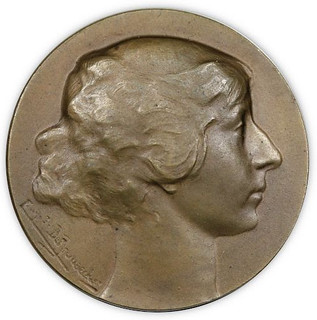 "Many thanks for your continued work on The E-Sylum. It is fun to examine and introduces
new material to me each week.
"Many thanks for your continued work on The E-Sylum. It is fun to examine and introduces
new material to me each week.
"Regarding the Belgium Vanity Skull medal, note the face facing left in the hairdo of the woman."
I saw that. Nice optical illusion in metal. These tricks are more common on paper money. Is anyone aware of other struck coins, tokens or medals with a similar dual image? -Editor
To read the earlier E-Sylum article, see:
SELECTIONS FROM DAVE WNUCK MAKING THE GRADE #44 (https://www.coinbooks.org/v24/esylum_v24n01a24.html)
Merlin's Red Dragon
Last week I quoted a source noting that "It can be hard to distinguish griffins from dragons, as both have four legs and wings. The griffin has a lion's body and eagle's head, and the dragon has a reptile's head and body, but the details need to be clearly shown to be certain which one you are looking at. Long legs and long ears probably indicate a griffin." -Editor
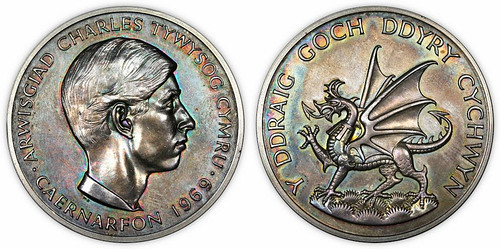
Chip Howell writes:
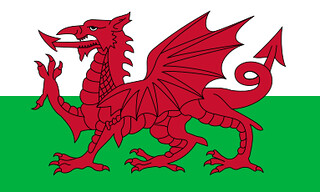 "Be that as it may, this medal celebrates Charles' investiture as Prince of Wales (Tywysog
Cymru) at the age of 21 in 1969. On the reverse "Y Ddraig Goch" = "the Red Dragon" which beast Merlin saw in a vision as representing the Welsh & also appears on the flag of Wales. I think it
safe to conclude, this is a dragon. Cymru am byth! (Wales Forever)."
"Be that as it may, this medal celebrates Charles' investiture as Prince of Wales (Tywysog
Cymru) at the age of 21 in 1969. On the reverse "Y Ddraig Goch" = "the Red Dragon" which beast Merlin saw in a vision as representing the Welsh & also appears on the flag of Wales. I think it
safe to conclude, this is a dragon. Cymru am byth! (Wales Forever)."
Thanks for setting us straight. Wouldn't want to anger a famous dragon. -Editor
For more information on the Wales flag, see:
Flag of Wales (https://en.wikipedia.org/wiki/Flag_of_Wales)
To read the earlier E-Sylum article, see:
SELECTIONS FROM DAVE WNUCK MAKING THE GRADE #44 (https://www.coinbooks.org/v24/esylum_v24n01a24.html)
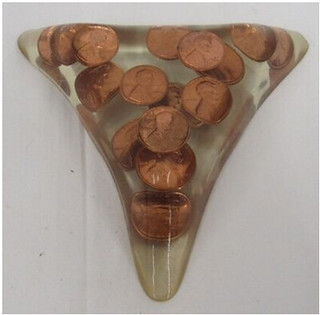 Cents in Shark Tooth Shaped Lucite
Cents in Shark Tooth Shaped Lucite
An E-Sylum reader writes:
"Attached is a photo of Lincoln Pennies encased in Lucite that will be offered up for auction Saturday 9 January 2021 in Hanover, Pa. It looks like the shape of a very large shark's tooth.
I've bought quite a few over the years at or under face value and then cut them out using a bandsaw and a large hammer. The silver I saved but the others I spent."
To read the earlier E-Sylum articles, see:
NOTES FROM E-SYLUM READERS: JANUARY 3, 2021 : Duckpin-Shaped Encased Dimes (https://www.coinbooks.org/v24/esylum_v24n01a12.html)
NOTES FROM E-SYLUM READERS: JANUARY 3, 2021 : Gloucester ShillingRare Encased Gloucester Shilling
(https://www.coinbooks.org/v24/esylum_v24n01a12.html)
Query: Swedish Artist "SIGG"
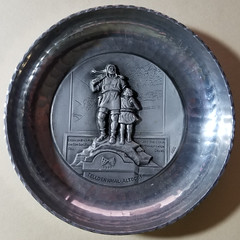
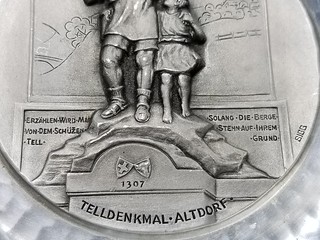
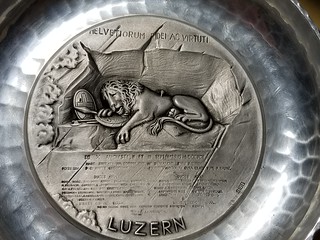

Rebekah Stafford writes:
"I have two items that I need some help on. They are Swedish and in the shape of a bowl, possibly the commemorative of Swiss monuments designed by someone named "Sigg". Do you have any "Swedish" experts/someone knowledgeable that could assist? I have found absolutely nothing (Google, etc.) that resembles what I have.
1-Lion Monument in Lucerne, Switzerland
2-Tell Monument in Uri, Switzerland"
Thanks!
Len Augsburger writes:
"The engraver "Sigg" isn't listed in the Forrer reference. My guess is that this started as a standalone medal, and then someone fashioned it into a finger bowl."
Rebekah adds:
"I was able to make out a very small inscription but it does say "hand hammered" on the backside under "Sigg" and "Switzerland".
"I spent an incredible amount of time on this and found that it might be Hermann Alfred Sigg."
Can anyone help? I can find references to Sigg paintings and prints, but nothing on any work as a medallist. -Editor
Brass Three Pence Inlaid with a Silver Three Pence
Regarding the Large Cent Inlaid with an Indian Head Cent from the stock of dealer Dave Wnuck, Bruce Perdue writes:
"I offer the attached image of a silver three pence encased or inset if you will in a brass three pence. This type of encased coin is not unknown."
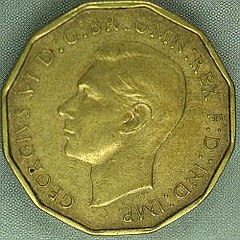
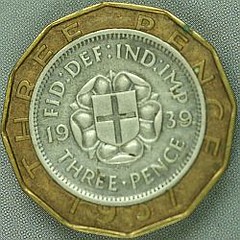
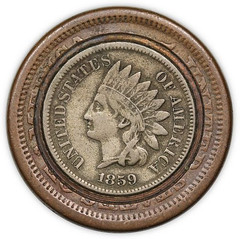 Thanks. Interesting items. Just unknown to me, I guess.
Thanks. Interesting items. Just unknown to me, I guess.
I'd joked that the small-inside-large cent was a U.S. Mint "salesman's sample" to show the size of the new small cents. It reminded me of the type of Bryan Dollars illustrating the relative sizes of a dollar's worth of silver under the current and proposed standards. -Editor
To read the earlier E-Sylum article, see:
SELECTIONS FROM DAVE WNUCK MAKING THE GRADE #44 : Large Cent Inlaid with an Indian Head Cent
(https://www.coinbooks.org/v24/esylum_v24n01a24.html)
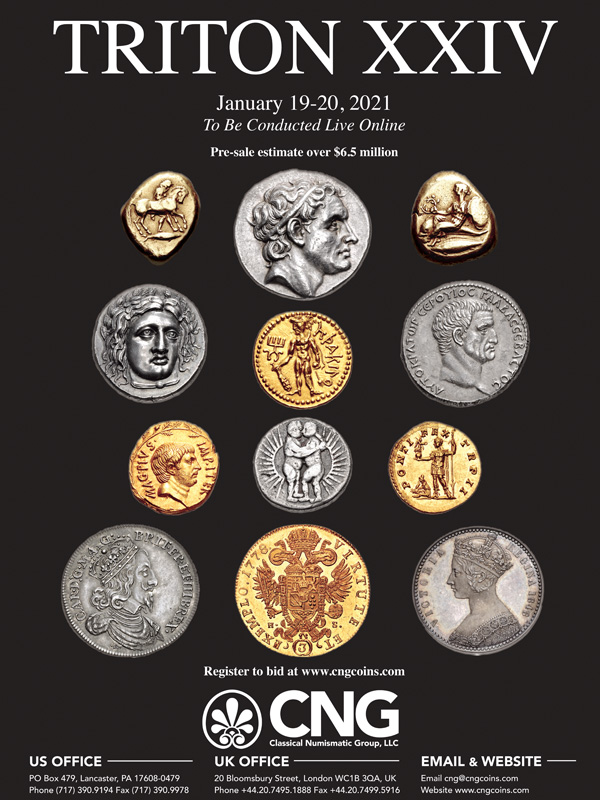
1921 SILVER COIN ANNIVERSARY ACT BECOMES LAW
In the how-about-some-GOOD-news-from-Washington department, the 1921 Silver Dollar Coin Anniversary Act has been signed into law. Here's an excerpt from Coin World's coverage. I added the image from our earlier articles. -Editor
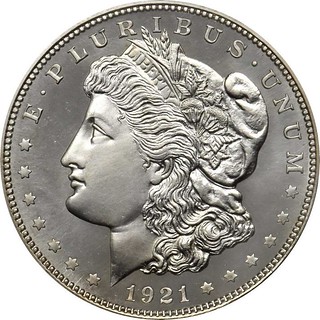 "Legislation was signed into law Jan. 5 by President Trump to authorize production in 2021 by
the U.S. Mint of coins marking the 100th anniversary of the transition of silver dollar production to the Peace dollar from the Morgan dollar.
"Legislation was signed into law Jan. 5 by President Trump to authorize production in 2021 by
the U.S. Mint of coins marking the 100th anniversary of the transition of silver dollar production to the Peace dollar from the Morgan dollar.
"H.R. 6192, the 1921 Silver Dollar Coin Anniversary Act, was introduced in the House March 11, 2020, by Rep. Andy Barr, R-Ky. H.R. 6192 was passed by the House Sept. 22, 2020. The Senate passed the measure Dec. 17 by unanimous consent.
"A mirror bill in the Senate, S. 4326, was introduced July 27, 2020, by Sen. Mike Enzi, R-Wyo.
"The successful legislative initiative was spearheaded by Citizens Coinage Advisory Committee Chairman Thomas J. Uram, and fellow CCAC member Michael F. Moran."
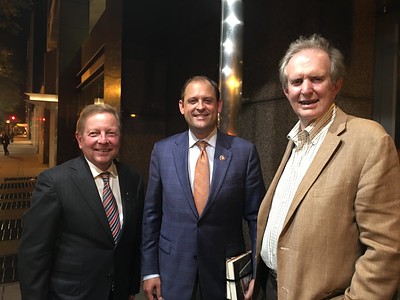
Tom Uram, Congressman Andy Barr and Mike Moran
at the first meeting to discuss the Bill (Tom Uram photo)
I think this is one of the best coinage ideas in a long time, and congratulations to Tom, Mike, the Pennsylvania Association of Numismatists and everyone involved in making this happen. It was a long journey with multiple fits and starts, and long stretches of wondering if and when anything would ever actually happen. While I'm among those who prefer original, new designs, I think this is a great way to commemorate anniversaries of two classic coin designs, and promote numismatics in general. -Editor
To read the complete Coin World article, see:
President Trump signs measure for centennial silver dollars
(https://www.coinworld.com/news/us-coins/president-trump-signs-measure-for-centennial-silver-dollars)
To read earlier E-Sylum articles, see:
SUPPORT THE 2021 SILVER DOLLAR COMMEMORATIVES! (https://www.coinbooks.org/v22/esylum_v22n30a14.html)
1921 SILVER DOLLAR ACT GAINS SPONSORS (https://www.coinbooks.org/v22/esylum_v22n45a16.html)
1921 SILVER COIN ANNIVERSARY ACT SUPPORT SOUGHT (https://www.coinbooks.org/v23/esylum_v23n12a17.html)
SUPPORT THE 2021 SILVER DOLLARS! (https://www.coinbooks.org/v23/esylum_v23n39a12.html)
1921 SILVER COIN ANNIVERSARY ACT PASSES (https://www.coinbooks.org/v23/esylum_v23n51a17.html)
THE BOOK BAZARRE
HOBO NICKEL CAST COPIES FLOOD MARKET
With permission, we're publishing this excerpt from Carol Bastable's President's Message in the Winter 2020 issue of Bo Tales, the official publication of the Original Hobo Nickel Society, Inc. Thanks. -Editor
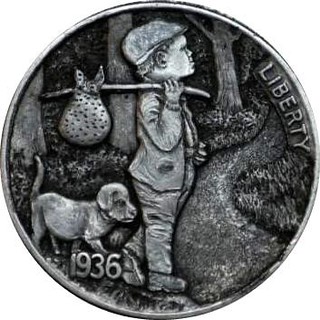
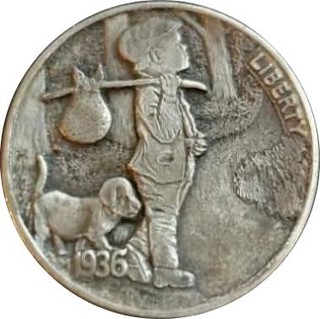
LEFT: Original carving; RIGHT: Fake copy
I would like to bring up the ongoing problem of hobo nickel cast coins that have been appearing on eBay. These are a problem from several perspectives. First, these are original designs stolen from the carvers that originally made them and can mean a loss of revenue for the carvers. Some people (maybe not members of our club) buy the castings because they cost pennies on the dollar compared to the original labor intensive carvings. Copies may even go as far as diluting the value of the original art. We have discussed the issue on our OHNS Facebook page ever since the first ones started showing up. China, who does not have copyright laws, has been the culprit in creating the copies. If you are an artist that has been copied, you can file a Vero report with eBay to try to have a listing pulled. It is a constant ongoing battle as one seller may get shut down; another one can pop up at any time.
While these copies are a plague for the original artists, it can also affect buyers when sellers do not disclose that they are copies. This happened in the beginning when the copies first hit the market. The copies were identified and posted on OHNS Facebook in order to immediately get the word out. As a result, multiple complaints went into eBay from our Facebook members and sellers were shutdown. We stayed vigilant about that and sellers soon realized that they would have to list these as copies, casings, tokens, fantasy issues, or the like. That worked well to keep buyers from getting scammed.
Unfortunately there was a recent instance of a seller from the U.S. that had some of these copies mixed in with other listings of real hobo nickels. This might have been a collection bought second hand and the seller was not expert enough on the subject to know what they owned. While many collectors of hobo nickels have become familiar with the look of the Chinese copies, some of these copies in this sellers group looked very real. And on top of that when the original artist notified the seller that they were counterfeit copies, the seller did not cancel the listings and eBay acted too slowly to pull the listings with copies then selling in the $175 range. Your safest bet is to buy directly from the artist or a seller you know well (preferably an OHNS member). OHNS can help arbitrate in a financial dealing gone wrong if both parties are club members. Remember the code of ethics that OHNS has members agree to and must abide by.
One other issue with these copies, even when listed correctly, is that they clog the search engine when one wants to find "real" hobo nickels and not wade through a bunch of junk!
Bibliophiles run across the same problem with reprints of out-of-copyright numismatic literature. Your heart skips a beat when you come across a listing of that rare work you've been seeking for years, only to discover that it's just a made-to-order printout of a publicly-available digital copy. They're perfectly legal when properly described, but a nuisance to those searching for the Real McCoy.
OHNS is experimenting with a way for legitimate sellers of genuine products to distinguish their listings, but as noted it's an endless game of Whack-A-Mole with unscrupulous sellers, who always find a way to reappear. -Editor
For more information on the Original Hobo Nickel Society, Inc, see:
http://www.hobonickels.org/
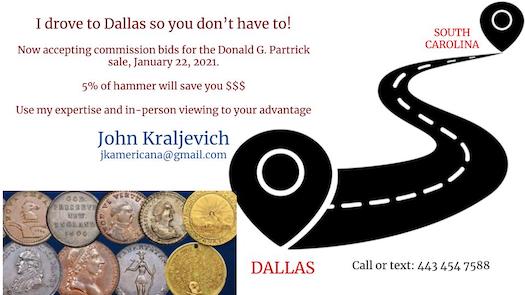
VOCABULARY TERM: COIN COLLECTING
Here's another entry from Dick Johnson's Encyclopedia of Coin and Medal Terminology, a great one about coin collecting itself. -Editor
Coin Collecting. Gathering specimens of coins in systematic fashion as an avocation or numismatic pursuit. Collecting coins appeals to every age from the child who can identify the portrait on a small bronze piece to the senior who can understand the language and symbolism on an obscure piece from a distant land or time, from the person with limited funds to the wealthiest benefactor. Gathering coins, it has been said, appeal to the magpie instincts in humans who like bright, shiny objects. Contrast this to the scientist/numismatist that likes to classify every species and subspecies, who like to describe and catalog every specimen in their collection and preserve them for future students to enjoy.
Coin collecting has occurred, it seems, ever since there were coins. Some ancient coin hoards that have been recovered intact that indicate the pieces were assembled for appreciation of the beauty of their design and differing characteristics, as a collection more so than an accumulation for commerce.
For the most passionate collector, collecting coins is an emotional involvement exhibited by the thrill of the chase, to acquire a desired specimen. After all, coin collecting appeals to very intelligent people. It fulfills a desire to complete a series; it requires a dedicated investment in intellect, time, savings, yet still has the romance of distant peoples, long ago time and a miniature art form of the time. If for no other reason we study coins because they are artifacts – actual money that contemporary custom had placed a value on these coined objects.
Because coins are issued by denomination, the design within that denomination is called a type. Often a single type will be issued over a number of years as the national authority (like a Treasury Department) attempts to supply its country with a quantity of circulating medium. Also, and particularly for large industrial countries, they may have more than one mint. Most mints have their own mark, mintmark, a signature on all the coins of their manufacture. Thus collecting by types, by dates and by mintmarks are important to collectors.
Any deviation in the design or form from the normal coin – whether intended or resulting from a manufacturing anomaly –results in a variety of the coin in that series. Collectors are very interested in varieties and closely study every aspect of the coin's design and production to identify these varieties, no matter how slight. The discovery of an unrecorded new major variety is an event of major proportions in the numismatic field.
Collectors quickly learn that some specimens are not easy to obtain. The concept of rarity is inherent to every collector. He learns that one variety may be quite rare and a similar one quite common. Rarity is based on the number originally made and how many of that number have survived. Numismatists have determined a survival ratio that indicates this degree for a particular rarity. Letter and number charts have been devised and published in numismatic literature to give an indication within a range of common to extreme rarity.
Coin collecting deals with coins in groups. Here are some group terms.
hoard – A retrieved group of monetary items.
series – Three or more coins with a common theme or design with a continuity of issue.
set – Two or more coins issued together.
Collection – Coins of any number gathered together for systematic study or the pleasure of ownership.
Rolls – Coins in uniform number packaged for commerce.
What to collect? Coin collectors first collect what is easiest for them to obtain, coins from circulation, their own nationality, an inherited collection. From early beginnings a collector typically moves into areas called specialties. Collectors cannot collect everything at once, so they specialize. He or she chooses an area of coin collecting which interests them most and which they devote their acquisition activities. These are also called topics. (In England they are called thematics.)
Even the average coin collector may easily complete a series. By obtaining all the varieties of specimens within that series he accomplishes a completeness that is psychological satisfying. From there he moves on to other specialties or topics. Or, more often, collects several topics at a time. Thus as one series is completed he can move on to another, occasionally selling one to finance the purchase of another. Sometimes these pursuits are lifetime activities, particularly where a topic is open ended and never can be "completed."
Choosing a topic is a very personal thing. Nobody can tell a collector what to collect. It comes from within a collector's psyche. It is what gives him pleasure, and he is willing to devote the required time and money to participate. (Collecting medals and tokens is even more selective, see the entry on mat code for determining what to collect.)
Coin collectors. Estimates of the number of coin collectors in American range from a few hundred thousand to as high as six million or about one in every forty Americans. The largest mailing list is maintained by the United States Mint, but critics say this includes coin buyers not necessarily collectors (the grandmothers who buy birth year sets for their grandchildren, for example).
There have been some prominent coin collectors in America. Philanthropist John Pierpont Morgan was an active collector, as were actor Adolph Monjou, Texas oilman Lamar Hunt, and Colonel Green (son of Hetty Green, the Witch of Wall Street).
No American president was known to have been a coin collector (like Franklin D. Roosevelt was a stamp collector). But heads of state of other countries were coin collectors. Most impressive was Victor Emmanual of Italy who was very active. Also, King Farouk of Egypt was a notorious coin collector. Several early monarchs formed collections which have become national treasures in their country's museums today.
A small industry has developed to supply the collector with the necessary accouterments to engage in collecting. Albums, envelopes, magnifying glasses, holders, everything that could aid in examining, organizing, displaying, housing and storing specimens has been manufactured for the collector.
Numismatic books and periodicals are widely published. The largest numismatic library is in New York City at the American Numismatic Society. It currently houses 100,000 items.
Collector organizations are formed at every level, local to national, specialized to international. Thus collectors with similar interests can meet with others of that interest, discuss the collector lore of their mutual activity, exchange duplicates perhaps, or just gain more knowledge of the subject. Talks at these meetings are often illustrated with slide presentations or the exhibition of actual specimens and information is widely exchanged. Collectors of the same specialty quickly form a close camaraderie.
Museums frequently form and display coin collections. The three largest in the United States with the widest breadth of holdings are the American Numismatic Society with a museum in New York City, the American Numismatic Association with a museum in their Colorado Springs headquarters, and the nation's coin collection at the Smithsonian Institution in Washington, DC.
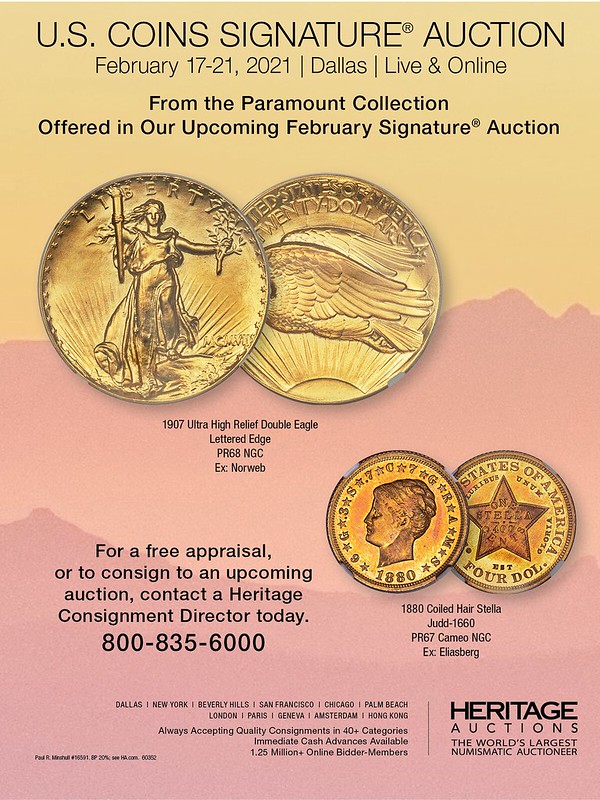
CHARLES WYLLYS BETTS (1845-1887)
John Lupia submitted the following information from the online draft of his book of numismatic biographies for this week's installment of his series. Thanks! As always, this is an excerpt with the full article and bibliography available online. This week's subject is U.S. numismatic pioneer and author Charles Wyllys Betts. -Editor
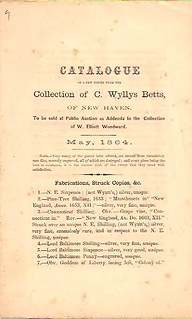 Betts, Charles Wyllys (1845-1887), Lawyer, Die Sinker, Coiner of Imitation Coins, Numismatist,
Author.
Betts, Charles Wyllys (1845-1887), Lawyer, Die Sinker, Coiner of Imitation Coins, Numismatist,
Author.
He was born on August 13, 1845, at Newburgh-on-the Hudson, Orange County, New York, the son of Judge Frederic Joel Betts (1803-1879) and Mary Ward Scoville (1813-1868).
In 1855, his family moved to New Haven, Connecticut. He and his older brother Frederic attended school preparing them for Yale where their father intended them to study law.
In July 1861, just before the outbreak of the Civil War, he was forced to leave school due to an illness. During his convalescence he began to collect coins as it was suggested to him for recreation. Since numismatics was suggested it probably meant that he was given to read on this subject. Contemporary with young Betts was the numismatic author, William Cowper Prime (1825-1905). In 1860, Prime published two articles in Harper's New Monthly Magazine; first, "Coins and Coinage," in January; and "Coins in America," February. The following year he published, Medals, and Seals, Ancient and Modern. Illustrated and Described... (New York: Harper & Brothers, 1861). Betts interest in coins was soon merged with his homeschooling lessons of early American history and his studies in the art of engraving.
It was fashionable for young schoolboys to learn the art of etching and engraving. It is possible that Mr. Root of New York, whom we shall see, Betts will write to him about Fugio dies available for purchase, was probably a man known to young Betts back in Newburgh, who could make medals, tokens and store cards. Sixteen year-old Betts appears to have applied his skill at engraving dies to make coins and medals celebrating real historical events and sometimes with his facts mixed-up. This was never done from a malevolent motive to deceive for profit duping an unsuspecting buyer, but rather, was done as an art form for amusement and with propriety. Betts tells us in his own words :
"It was in 1860 that I made my first attempt at die cutting and the occasion was a receipt of a quantity of coins and medals from some New York dealers for inspection. After selecting those which my collection lacked, I sold the rest to various collectors in New Haven, and thereupon in commemoration of this business enterprise I struck a medal with the obverse : CONNECTICUT, with three pine trees in the center, and on the reverse my own name, with the words, "Coins and Medals, New Haven, 1860."
About half a dozen were struck in lead and one in copper. The later is in the Yale College collection, and is a very good impression. The die is altered to 1861.
My next attempt at coinage was a leaden token with the inscription, "Colony of New Yorke," the latter words being on the obverse surrounding a head. One of these tokens I sent to Mr. Mickley of Philadelphia.
It was some time before I acquired sufficient skill to make impressions in any metal but lead. The dies were cut in copper or sometimes brass, and were so soft as to be often destroyed in the attempt to stamp upon copper or silver. I believe that my first successful impression upon copper was from dies having the obverse of the "Nova Eborac," and the reverse, "Immune Columbia."
The dies were cut upon coins of the halfpenny size, either worn smooth, or filed away on one side. My only tool was an awl for cutting the letters and the outlines of the figures, and a knife for gouging out the broader parts of the designs. When the cutting was finished each die was heated white hot and dipped into cold water. A third smooth cooper of the halfpenny size was then heated and placed between the dies, and the three being quickly rolled together in sheet lead from a tea box, to prevent them from slipping, were pounded upon an anvil with a six-pound dumbbell. The heating process gave an air of antiquity to the pieces.
Unfortunately, someone, about 1862, presented me with a set of letters (i.e., punches) and several engraving tools and in learning the use of them I made a great number of store cards and medalets, most of which are unique, and all, I think, in the Yale College collection.
The earlier ones I look upon with some interest because they used to afford me a great deal of amusement, not only in the making, but in the astonishment of collectors when looking over my cabinet."
These specimens are now celebrated as the "Betts Fantasy Pieces", which fooled serious collectors who came by them at sales unaware of their creation by a schoolboy, and so, it perplexed and vexed many who acquired them having sometimes paid much during the 1870's and later.
All of this mishap could have been avoided had these coin collectors kept abreast of the numismatic literature circulating in their day. It had been widely known through the efforts of William Elliot Woodward (1825-1892), a coin dealer from Roxbury, Massachusetts, and one of the earliest full-time coin dealers in the country, in his 9th coin auction sale, to the keen collector as early as mid 1864 that Betts produced fabrications of many coins. On May 17-20, 1864, W. Elliot Woodward published an addenda to this catalog of coins, medals and tokens belonging to John F. McCoy to be sold at auction by Leavitt, New York, containing a list of 45 fabrications and struck copies of coins and medals from Betts' coin collection. Had coin collectors kept abreast of this 9th Woodward sale and the notices published in The Coin Collectors Journal and in Numisma by Edouard Frossard in 1877 and 1878-1879 respectively their sense of loss could have been avoided.
Besides his own creations of fictitious colonial coins and medals Betts would hunt for genuine specimens by scouring the vicinity of New Haven on coin hunting expeditions, making inquiries and various purchases in order to build his collection for numismatic study and amusement.
On June 11, 1863, he sold his modest collection of thirty medals through William Harvey Strobridge in an addendum to the sale of the Late Hon. Henry Augustus Muhlenberg, Esq [1823-1854] that was held beginning June 9,1863, at the auction house of Bangs, Merwin & Co., Irving Building, 594 and 596 Broadway, New York City, New York.
He was putting numismatics aside as he entered Yale College in 1863, and as we have already seen sold 45 fabrication coins and medals in 1864 through Woodward. Regardless, he graduated Yale College in 1867, and won prizes for excellence in literature composition. In 1869, he graduated Columbia Law School, New York City, New York, and was admitted to the bar. In 1871, he completed post-graduate studies at Yale University. Consequently, from 1863 to 1871 Betts was assiduously busy with studies at school and had no time to devote to numismatics.
After graduation he entered the law office of Whitney & Betts, i.e., his elder brother Frederic H. Betts.
In 1875, the Betts brothers formed their own law office F.H & C. W. Betts, which in 1878 became Betts, Atterbury & Betts, where he continued practicing law up until his death.
He married in 1879 and his wife died in 1880.
In the spring of 1884 he resumed coin collecting and soon became a resident member of the ANS.
In April 1886, he gave an address to the ANS, "Counterfeit Half Pence Current in the American Colonies and their Issue from the Mints of Connecticut and Vermont," which was printed by request of the Society and distributed since it was a landmark paper and forms the foundation on all subsequent research of American colonial counterfeiting 1785-1788. Nearly three-quarters of a century later this essay was so highly regarded as precious that George Fuld and Robert Vlack reprinted it again early in 1960. A second reprinting was done by Jim Spilman in the June 1981 issue of The Colonial Newsletter, but with corrections and additions that aid the reader in identifying specimens by Vlack, Bressett and Barnsley/Miller attributions.
He was a specialist of Admiral Vernon Medals, and cataloged and described 167 varieties.
His opus magnus, American Colonial History Illustrated by Contemporary Medals, was left unfinished by his sudden and unexpected death. It was completed by his brother Frederic Henry Betts, William Sumner Appleton, Lyman Haynes Low, and William Theophilus Rogers Marvin, and published posthumously in 1894, seven years after his demise.
In May 1886, he left for a trip to Europe and visited the British Museum, London, and the Paris Mint in order to do research for his manuscript, American Colonial History Illustrated by Contemporary Medals. He died less than a year later. In November 1886 he corresponded with Steuben Jenkins about an Indian medal, Betts 164. One letter of correspondence together with Betts' rubbings and sketch are in the Lupia Numismatic Library and were published in the Medal Collectors of America (MCA) Advisory.
It was on a Wednesday, April 27, 1887, that he died of pneumonia at his brother Frederic's home at 78 Irving Place, New York City, New York. He was surrounded by his brother's family : his sister-in-law Louise, two nephews, Frederic, Jr and Wyllys, and his niece Mary Betts.
To read the complete article, see:
BETTS, CHARLES WYLLYS (http://www.numismaticmall.com/numismaticmall-com/betts-charles-wyllys)
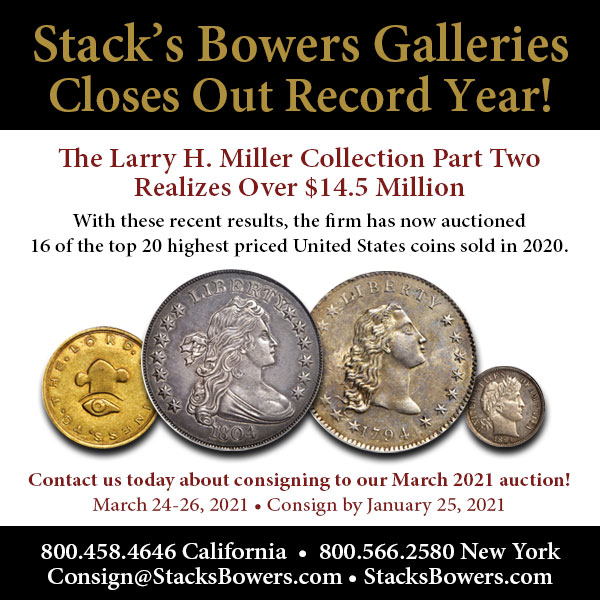
STEPHEN ALBUM RARE COINS AUCTION 39
Here's the press release for Stephen Album Rare Coins upcoming Auction 39. Some great coins as always, and many lots of literature for the researcher and bibliophile. -Editor
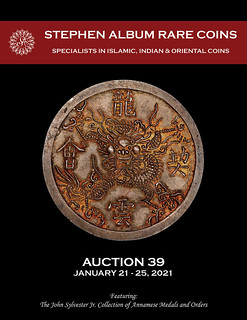 Stephen Album Rare Coins will hold its Auction 39 on January 21-25, 2021 at its offices in
Santa Rosa, California. The auction is made up of an even 4,500 lots of Ancient, Islamic, Chinese, General World, and Indian Coins as well as Numismatic Literature. Featured in this sale is The John
Sylvester Jr. Collection of Annamese Medals and Orders, highlighted by several pieces never-before seen at auction.
Stephen Album Rare Coins will hold its Auction 39 on January 21-25, 2021 at its offices in
Santa Rosa, California. The auction is made up of an even 4,500 lots of Ancient, Islamic, Chinese, General World, and Indian Coins as well as Numismatic Literature. Featured in this sale is The John
Sylvester Jr. Collection of Annamese Medals and Orders, highlighted by several pieces never-before seen at auction.
Some highlights from the sale follow:
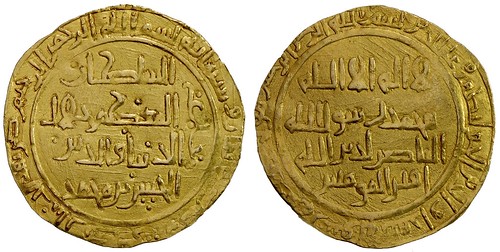
LOT 558. ISLAMIC: ASSASSINS AT ALAMUT (BATINID): al-Hasan III, 1210-1221, AV dinar (5.22g), Kursi al-Daylam, AH608, A-C1920, Vardanyan—, Both the obverse and reverse calligraphic style is similar to contemporary Ghorid and Khwarizmshah gold coinage. The obverse has the royal titles, al-sultan / al-mu'azzam jalal / al-dunya wa'l-din / al-hasan bin muhammad, with the mint/date formula in the margin. The reverse is traditionally Sunni, la ilah illa Allah / muhammad rasul Allah / al-nasir li-din Allah / amir al-mu'minin, with bism Allah al-rahman al-rahim followed by part of the Qur'an verse 9:33 in the margin. This example is exquisitely struck and is likely the finest known Batinid coin of any of the six rulers who issued coins., EF, RRRR. Estimated at $18,000 - 20,000.
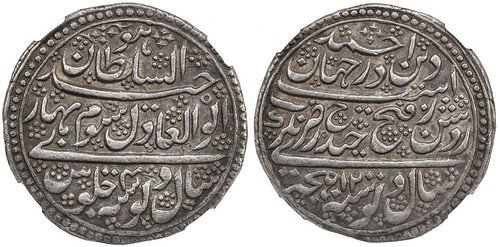
LOT 914. INDIA: MYSORE: Tipu Sultan, 1782-1799, AR double rupee (22.55g), Nagar, AH1200 year 4, KM-107, Persian legends; huwa al-sultan al-waheed al-adil suyeem bahari sal dalaw sanah 4 julus // ahmad deen dar jahan ast roshan za rateh haidar (letter he) zarb nagar sal dalaw sanah 1200 hijri, extremely rare mint for all silver coinage of Mysore, especially the double rupee, NGC graded AU55, RRR. Estimated at $10,000 - 12,000.
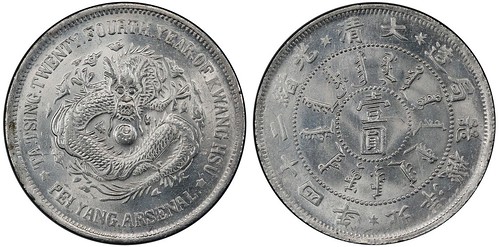
LOT 1182. CHINA: CHIHLI: Kuang Hsu, 1875-1908, AR dollar, Peiyang Arsenal mint, Tientsin, year 24 (1898), Y-65.2, L&M-449, dragon eyes in relief, a superb quality example with bright white original mint luster, a gorgeous example! PCGS graded MS63+. Estimated at $18,000 - 22,000.
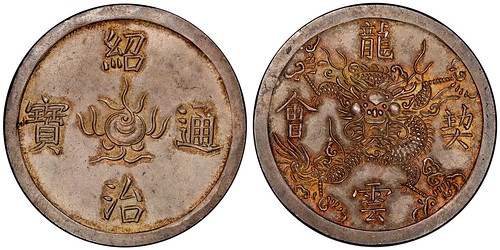
LOT 1466. WORLD: NGUYEN DYNASTY (DAI NAM): Thieu Tri, 1841-1848, AR 5 tien (18.93g), KM-286, Schroeder-261, 45mm, a lovely toned high grade mint state example of this large Annamese silver type! PCGS graded MS64, ex Gustaf Melin Collection. Estimated at $12,000 - 14,000.
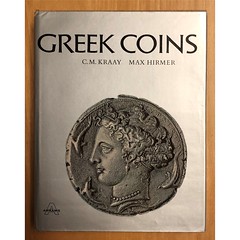 LOT 4238. LITERATURE: Kraay, Colin M., Greek Coins, New York, 1966, Harry N. Abrams
Publisher, First Edition, 396 pages, hardcover with dust jacket. David Sear, authors of the most widely used reference books on ancient coins, wrote about his book on his website: "Undoubtedly, the
ultimate book in this field is the monumental "Greek Coins", with authoritative text by Colin Kraay and superb photographic illustrations (including many enlargements) by the renowned photographer
Max Hirmer. Published in 1966, this large format work has been long out of print and is in great demand. Estimated at $300 – 500.
LOT 4238. LITERATURE: Kraay, Colin M., Greek Coins, New York, 1966, Harry N. Abrams
Publisher, First Edition, 396 pages, hardcover with dust jacket. David Sear, authors of the most widely used reference books on ancient coins, wrote about his book on his website: "Undoubtedly, the
ultimate book in this field is the monumental "Greek Coins", with authoritative text by Colin Kraay and superb photographic illustrations (including many enlargements) by the renowned photographer
Max Hirmer. Published in 1966, this large format work has been long out of print and is in great demand. Estimated at $300 – 500.
The firm is now taking consignments for its Auction 40, which will be held May 13-15, 2021. More information can be found on their website at www.stevealbum.com
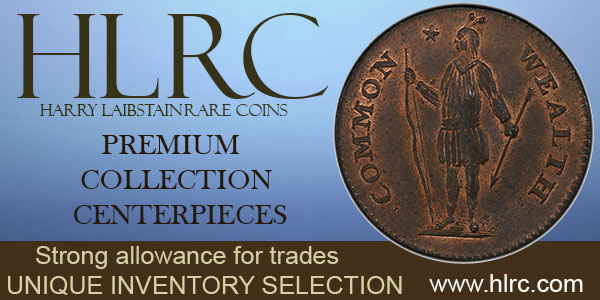
NUMISMATIC NUGGETS: JANUARY 10, 2021
Here's a selection of interesting or unusual items I came across in the marketplace this week. Tell us what you think of some of these. -Editor
1708 Augsburg Gold Two Ducats
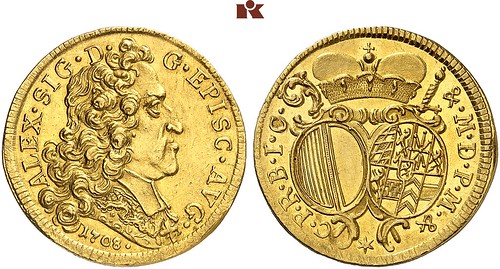
Alexander Sigismund von Pfalz-Neuburg, 1690-1737. 2 Dukaten 1708, Augsburg. 6.95 g. ALEX Û SIG Û D Û - G Û EPISC Û AVG Û Brustbild r. darunter 1708 Û//C Û P Û R Û B Û I Û C Û - & Û M Û D Û P Û M Û & Die Wappenschilde des Hochstifts und von Pfalz-Neuburg, darüber Fürstenkrone, dahinter Krummstab und Schwert, unten Stern. Forster 401; Fb. 114.
GOLD. Von größter Seltenheit. Prachtexemplar. Feine Goldtönung, vorzüglich-Stempelglanz
From the Künker sale 346. -Editor
To read the complete lot description, see:
Alexander Sigismund von Pfalz-Neuburg, 1690-1737. 2 Dukaten 1708, (https://www.kuenker.de/en/auktionen/stueck/280658)
E.P. EVERETT Counterstamp on Large Cent
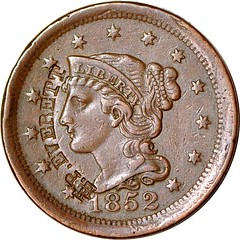
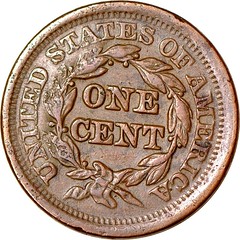
1852 1C Braided Hair Large Cent
Counterstamp "E.P. EVERETT"
Extra Fine
A very nice, carefully placed counterstamp. Found on eBay. -Editor
To read the complete lot description, see:
1852 1C Counterstamp "E.P. EVERETT" Braided Hair Large Cent XF K11405 (https://www.ebay.com/i/184499084808)
Ehrlich-Hata Syphilis Medal
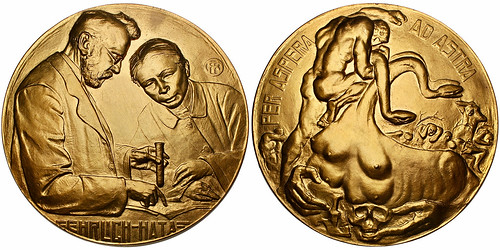
101429 | GERMANY & JAPAN. Paul Ehrlich & Sahachiro Hata bronze Medal. Issued circa 1912. Commemorating their breakthrough research on the treatment of syphilis (65mm, 117.90 g, 12h). By F. Kounitzky.
Half length busts of Ehrlich, holding test tube, and Nata, reading through their notes; =EHRLICH–NATA= in exergue / PER ASPERA AD ASTRA (through the hardships to the stars), nude male fighting back serpentine anthropomorphic monster (representing syphilis) clutching human skull; other men in background wracked with madness. Edge: Plain.
Paul Ehrlich was an important German physician and scientist who contributed greatly to the field of immunology. Awarded the Nobel Prize in Physiology/Medicine in 1908 for the standardization of manufacturing anti-diphtheria serum, he actually garnered even more fame through a discovery with fellow researcher, Sahachiro Hata from Japan. This breakthrough involved arsphenamine (also known as Salvarsan or compound 606) and was the first effective treatment for syphilis.
From the stock of Jeremy Bostwick's Numismagram. -Editor
To read the complete item description, see:
101429 | GERMANY & JAPAN. Ehrlich & Hata "Syphilis" bronze Medal. (https://www.numismagram.com/product-page/101429)
1964 Kennedy Half Struck on a Clad Quarter Planchet
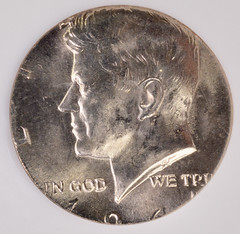
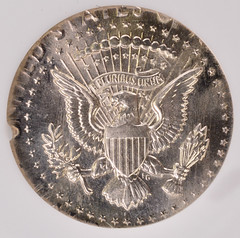
NGC 1964 Kennedy half transitional off-metal struck on a clad quarter planchet.
The coin is a rare transitional off-metal, being not only on a quarter planchet, but also on a clad quarter planchet. For the year 1964, quarter planchets were made of silver, but this coin is struck on the next year's quarter planchet, 1965, which is the year quarters officially were struck in clad metal.
Transitional off-metals are one of the rarest error types because they are so unlikely to occur. There are few known clad 1964 Kennedy halves, and perhaps there are around 10 or so known. This is one of the higher grade examples you will find. A popular error type!
Amazing error - I'd never heard of this one. From the new stock of error dealer Jon Sullivan. -Editor
To read the complete item description, see:
ngc 50c 1964 kennedy half transitional off-metal on clad quarter
planchet ms64 (https://www.sullivannumismatics.com/coin/ngc-50c-1964-kennedy-half-transitional-metal-clad-quarter-planchet-ms64?v=6807)
Chartered Mercantile Bank of India, London and China $5 Specimen
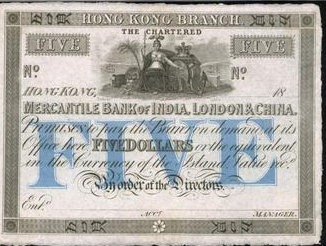
The Chartered Mercantile Bank of India, London and China, $5, specimen, 18__ (ca.1858), grey and blue on white paper, Britannia at upper centre, denomination in Chinese characters within border, 'FIVE' on either side, blue 'FIVE' at lower centre, a uniface note printed by Batho and Co., (Pick 82), PMG 58 Choice About Uncirculated. A superb note of the highest rarity and likely the earliest note designed for Hong Kong available. Of the highest historical importance.
From the SPINK China January 2021 Hong Kong sale. -Editor
To read the complete lot description, see:
THE CHARTERED MERCANTILE BANK OF INDIA, LONDON AND CHINA, $5,
SPECIMEN, 18__ (CA.1858), (PICK 8... (https://live.spink.com/lots/view/4-1JA4F9/the-chartered-mercantile-bank-of-india-london-and-china-5-specimen-18-ca1858-pick-8)

THE 1757 DASSIER 10-RUBLE COIN
This Künker press release discusses a very interesting Russian coin. -Editor
The last years in the life of Jacques-Antoine Dassier
On January 28, 2021, a Künker auction presents a 10-ruble piece from 1757 whose die was created by the Genevan medalist Jacques-Antoine Dassier. But this is not the only special thing about it: A small collector's hallmark proves it once belonged to the Hutten-Czapski collection.
On August 3, 1765, Jacques-Antoine Dassier signed a contract engaging him to go to Russia as a medalist. What had led to this point? Why did Empress Elizabeth, the daughter of Peter the Great, choose a medalist from Geneva, out of all possibilities, to design coins and medals at her court?
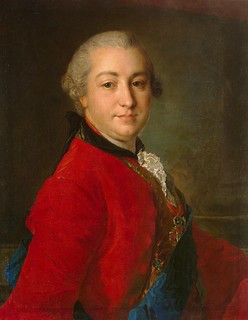
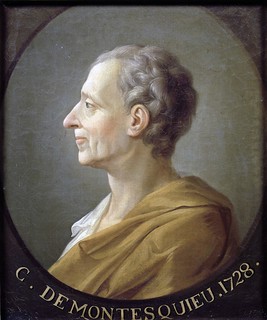
LEFT: Portrait of the Count Ivan Ivanovich Shuvalov. Painting by Fyodor Rokotov.
RIGHT: Jacques-Antoine Dassier's portrait of Montesquieu shaped our image of this great thinker. Anonymous painting from the end of the 18th century.
How to make friends at court
A Genevan goldsmith by the name of Jérémie Pauzié who worked at Elizabeth's court has left us with his version of the occurrences. In his memoirs, he recounts traveling back to his old hometown in
the years 1750 and 1751. In Geneva – then a hub of the luxury industry – he took the opportunity to do some extensive shopping. He knew quite well that Genevan products like watches and jewelry would
be met with strong demand back in Russia. One destination during his shopping spree was the studio of Jean Dassier, at the time already 84 years old, where he bought numerous medals. These were to
help Pauzié win over the essential decision-makers in order to gain employment for his own son.
Back in Petersburg, Pauzié went to the court. He was greeted by Ivan Ivanovich Shuvalov, a favorite and lover of the Empress, who immediately wanted to see what Pauzié had brought from Geneva. Pauzié showed him Dassier's medals, and Shuvalov was delighted. "If the Empress sees those, Her Majesty will buy them immediately", he is quoted. Consequently, Pauzié gifted the medals to Shuvalov (certainly not without ulterior motives) and said he had brought a second set for Her Majesty.
Not surprisingly, Pauzié was received by the Empress straightaway, who was eager to see the precious things brought from Geneva. Pauzié laid them out before her: a golden egg trimmed with gemstones in the form of the imperial double eagle and Elizabeth's name, a pretty pendent and a ring bearing a tiny watch by Jean-Jacques Pallard inside. The Empress was in raptures, asked to see the invoice and, without hesitating, agreed to the requested 12,000 rubles. To give some perspective: A teacher at the Academy of Arts founded by Shuvalov made only 1,000 rubles a year. After that, Pauzié reportedly gifted her the medals from Dassier's workshop. He describes Elizabeth as being so thrilled that she insisted on having Dassier at her court.
A new cultural policy for Russia
We don't know if this is how things actually happened, or if Pauzié just wanted to earn the praise for bringing Dassier to Saint Petersburg. Either way, his appointment went hand in hand with
Shuvalov's cultural policy which, more than before, was based on the French-speaking regions.
To his contemporaries, Ivan Ivanovich Shuvalov was the patron of Russian Enlightenment. He stood in correspondence with Voltaire and the editors of the Encyclopédie, Diderot and d'Alembert; he supported Mikhail Lomonosov in the founding of a university in Moscow; he initiated a Russian newspaper and dreamed of establishing an art academy in his own palace.
One of the teachers he brought to Russia for this purpose was in fact the son of Jean Dassier, Jacques-Antoine Dassier, at the time most certainly among the most well-known portraitists and die-cutters in all of Europe. He belonged to a famous Genevan dynasty of die-cutters who made their living by creating numismatic works of art collected all over Europe. Their medal suites on the famous reformers, on the celebrities of the Louis XV era, on the British kings or on Roman history – just to name a few – were bestsellers. Only three years earlier, Jacques-Antoine Dassier had captured the attention of the educated society with his depiction of near-blind Montesquieu, which was considered to be genius.
Thus, his appointment to the Petersburg court – whether with or without the aid of Pauzié – was definitely a coup.
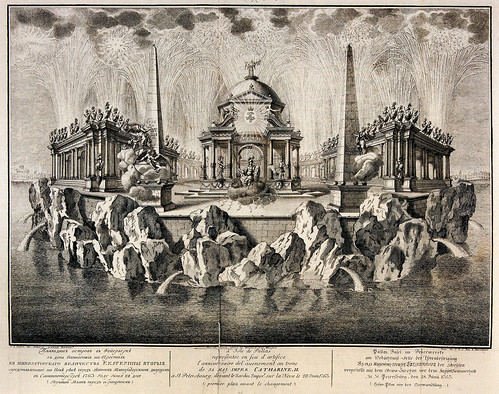
A court festival with fireworks under Catherine the Great, organized by Jacob Staehlin, on June 28, 1763.
Chief engraver of the Saint Petersburg Mint
Dassier's direct superior was not Shuvalov, but Jacob Staehlin from Swabia. In today's words, we would probably best describe his tasks as what is known to us as marketing and PR. For example,
Staehlin created the impermanent wooden triumphal arches and decorations that were needed for all celebrations of moving out and in. He created the drafts for emblems and tomb monuments. He also
thought up such fleeting works of art like the Baroque fireworks which were an indispensable element of every court festival. He represented what we would nowadays call corporate identity – making
sure that the Empress's appearance was always flawless, whatever the circumstances.
His tasks included supervising the production of coins and medals and defining the inscriptions and motifs, and thus, he became Jacques-Antoine Dassier's superior. We know that the two artists got along perfectly. And thanks to Staehlin's writings, we are very well informed about Dassier's work.
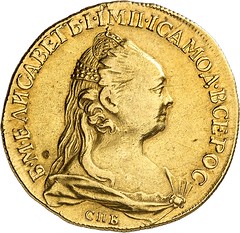
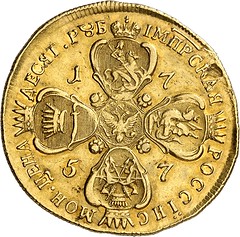
Russia. Elizabeth. 1741-1761. 10 rubles, 1757, St. Petersburg. Die by Jacques-Antoine Dassier. With collector's hallmark of Hutten-Czapski. Very rare. Almost extremely fine. Estimate: € 15,000. From Künker Auction 346 (28 January, 2021), No. 591.
After his arrival, Dassier worked on three projects simultaneously: on a nowadays extremely rare medal for his patron Shuvalov, on a die for ruble pieces and on the die for the item that is offered at Künker on January 28, 2021 – a 10-ruble piece from 1757.
Dassier's tasks and income
Dassier had not been employed just to make dies. His two-year contract specifically stipulated that he should teach "the art of engraving coins and medals to as many Russian students as required".
For this, he was paid 2,500 rubles a year, plus 250 Dutch ducats to cover travel expenses, and another 500 rubles for paying an assistant who would support him in his work. Besides, he probably
enjoyed free lodging.
After two years, Dassier renegotiated. He now received a yearly salary of 3,000 rubles, plus 500 rubles for every die he completed. This is all the more astounding as it turned out that, due to his ever-worsening tuberculosis, Dassier was in fact unable to teach young artists on a regular basis.
Instead, Staehlin and Shuvalov discussed his participation in a medal suite of 150 to 180 items, dedicated to the achievements of Peter the Great.
By that time, though, Jacques-Antoine Dassier was already so severely ill that he wished to return home. In the fall of 1759, he boarded an English ship, but only made it to Copenhagen. Testimony of his importance is the fact that the Danish Prime Minister himself accommodated Dassier in his own home, where he died on October 21, 1759.
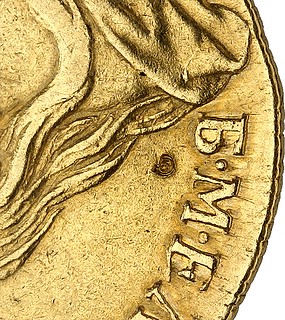 An exquisite provenance
An exquisite provenance
The coin offered by Künker, testimony of Jacques-Antoine Dassier's activities in Russia, was once part of the collection of Count (and numismatist) Emeryk Hutten-Czapski, as we can see from the
collector's hallmark. This well-known Polish nobleman, who gave his name to the numismatic museum of Krakow, the "Emeryk Hutten-Czapski Museum", worked in the Russian administration. During his stay
in Russia, he gathered an extensive collection of Russian coins and medals, which he sold between 1882 and 1884 in order to expand his specialty field, Poland.
By the way, in 2017 Künker offered a ruble of Peter the Great dated 1707 from the Hutten-Czapski collection. In 2019 there was a set of three platinum coins from the Hutten-Czapski collection in a Künker sale. The ruble sold for 290.000 euros, the platinum set for 750.000 euros.
Which price will the Dassier 10 ruble piece score? We shall see …
To visit the Künker website:
https://www.kuenker.de/en

H. G. WELLS COMMEMORATIVE COIN CONTROVERSY
It's rare that a new coin design DOESN'T spark objections from various corners. The latest controversy is over the Royal Mint's new coin commemorating the works of author H. G. Wells. Scott Miller submitted these comments. -Editor
My son just sent me a message about the new UK H G Wells commemorative coin with the comment "can I just note that the big walking machine on the coin has four legs?"
For those unfamiliar with "The War of the Worlds", the appropriate passage is
"And this Thing I saw! How can I describe it? A monstrous tripod, higher than many houses, striding over the young pine trees, and smashing them aside in its career; a walking engine of glittering metal, striding now across the heather; articulate ropes of steel dangling from it, and the clattering tumult of its passage mingling with the riot of the thunder."
Perhaps we should blame it on the new math?
David Pickup forwarded this story from The Guardian. Thanks! -Editor
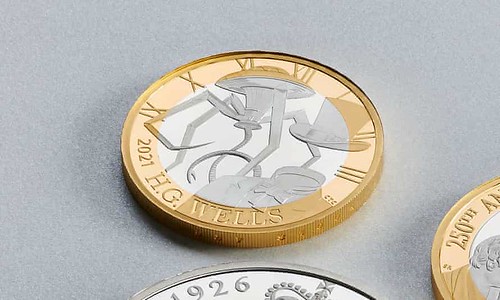
Observant fans of HG Wells have questioned how a new coin from the Royal Mint commemorating The War of the Worlds author could be released with multiple errors, including giving his "monstrous tripod" four legs.
The £2 coin is intended to mark 75 years since the death of Wells, and includes imagery inspired by The War of the Worlds and The Invisible Man.
Unfortunately, it strays from Wells's vision of his creations. "As someone who particularly likes one of his very famous stories, can I just note that the big walking machine on the coin has four legs? Four legs. The man famous for creating the Martian TRIpod," wrote artist Holly Humphries. "How many people did this have to go through? Did they know how to count?"
Science fiction novelist and professor of 19th-century literature Adam Roberts, who is author of a biography of Wells and vice president of the HG Wells Society, also criticised the depiction of the Invisible Man, shown in a top hat; in the book he arrives at Iping under a "wide-brimmed hat".
"It's nice to see Wells memorialised, but it would have been nicer for them to get things right," Roberts said. "A tripod with four legs is hard to comprehend (tri: the clue is in the name), and Wells's (distinctly ungentlemanly) invisible man, Griffin, never wore a top hat ... I'd say Wells would be annoyed by this carelessness: he took immense pains to get things right in his own work – inviting translators of his book to stay with him to help the process and minimise errors and so on."
Asked about the errors, a spokesperson for The Royal Mint said, "We have created a new £2 coin to celebrate the life and works of HG Wells. The coin depicts scenes from famous works such as War of the Worlds and the Invisible Man as imagined by designer Chris Costello." Costello has said he was inspired by "vintage HG Wells book covers and movie posters".
David adds:
"It is the first time the invisible man has been seen on a coin."
I can't remember if I read the book, but I've certainly seen the movies. I have to agree that the top hat seems incongruous. A floppy-wide brimmed hat help hide the Invisible Man's bandaged head when clothed and visible. As for the Martian walker (a forerunner of the Star Wars Imperial Walkers, I assume), to me it seems to have the requisite three legs, plus an arm and a tendril - I wouldn't count either of those as a fourth leg, but the arm could be misinterpreted as one. -Editor
To read the complete article, see:
HG Wells fans spot numerous errors on Royal Mint's new £2 coin
(https://www.theguardian.com/books/2021/jan/05/hg-wells-fans-spot-numerous-errors-on-royal-mints-new-2-coin)
Here's an article with additional comments from designer Costello. -Editor
Chris Costello, the coin's designer, insisted he was intentionally reinterpreting imagery from Wells' works for a modern audience.
"The characters in 'War of the Worlds' have been depicted many times, and I wanted to create something original and contemporary," he said.
"My design takes inspiration from a variety of machines featured in the book -- including tripods and the handling machines which have five jointed legs and multiple appendages. The final design combines multiple stories into one stylized and unified composition that is emblematic of all of H.G. Well's (sic) work and fits the unique canvas of a coin."
To read the earlier E-Sylum article, see:
The UK's new HG Wells coin features numerous errors -- including a
four-legged tripod (https://www.kitv.com/story/43135640/the-uks-new-hg-wells-coin-features-numerous-errors-including-a-four-legged-tripod)
Arthur Shippee passed along a New York Times article on the coin. Thanks. -Editor
To read the complete article, see:
Fans of H.G. Wells Cry Foul Over Errors in Commemorative Coin
(https://www.nytimes.com/2021/01/07/world/europe/hg-wells-coin-royal-mint.html)

ZERO CENTS NO-TIP KOOKIE KOIN
I didn't realize the website Quora was still around. The format is centered around questions that other readers are asked to answer. Like all social media sites, popular topics float to the top, resulting in a lot of clickbait about celebrities. I got sucked in during the pandemic lockdowns and sometimes find myself wasting time scrolling through because every now and then something turns out to actually be of interest, like this one.
This question ended up eliciting a somewhat numismatic answer from one of the respondents: "Have you ever directly told a waiter at a restaurant that their service was no good?" -Editor
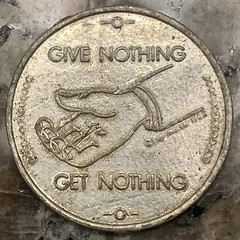
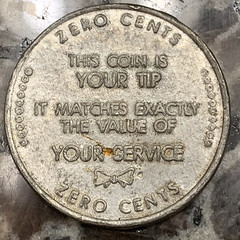
Rob Massey responded:
"Many years ago I came across 3 of these coins at a flea market and purchased them. Throughout all of those years I have handed 1 of them to a waiter.
"Now, for years, I have always carried one of these coins in my wallet for just this occasion. Although I really had never planned to use one, the time had come. I informed him that we were leaving and directly provided him with payment in full. That "payment in full" being the coin pictured above.
"He took one look at the coin, front and back. He then said "Pffft", threw the coin on the table, and stormed away.
"So now I carry coin #2 of 3 in my wallet, and hope that I never have occasion to use one of these again."
To read the complete article, see:
Have you ever directly told a waiter at a restaurant that their service was no
good? (https://www.quora.com/Have-you-ever-directly-told-a-waiter-at-a-restaurant-that-their-service-was-no-good)
These seem to be plentiful on the internet. I couldn't quite read the tiny copyright notice, but thanks to a search I now know it says "© Roy Morser 1962" Here's a tokencatalog.com entry. -Editor
ZERO CENTS / THIS COIN IS / YOUR TIP / IT MATCHES EXACTLY / THE VALUE OF / YOUR SERVICE / (bowtie) / ZERO CENTS GIVE NOTHING / (hand) / © Roy Morser 1962 / GET NOTHING
TC-272592
TIME MAGAZINE October 02, 1964 ------------- "For grumpy citizens, weary of waiters, cabbies and similarly unappealing personnel who do a fast, sloppy job, then present open, demanding palms,
Mendelsohn's in New Rochelle, N.Y., offers a solution. It is a coin that looks like a quarter, feels like a quarter, generally passes for the genuine article until the tipper is safely out of reach.
Too late, open, demanding eyes will discover the drawing of an outstretched hand where George Washington should be, and instead of an eagle, the straightforward, gloriously embossed message: THIS
COIN is YOUR TIP. GIVE NOTHING. GET NOTHING. ZERO CENTS. IT MATCHES EXACTLY THE VALUE OF YOUR SERVICE."
To read the complete entry, see:
New Rochelle, New York (Westchester County), U.S.A.
(http://tokencatalog.com/token_record_forms.php?action=DisplayTokenRecord&td_id=272592)
Here are a couple 1963 references found via Newspapers.com. -Editor
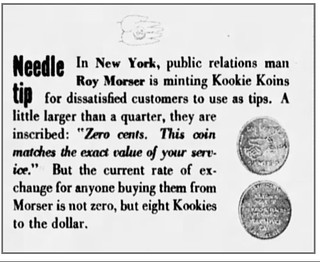
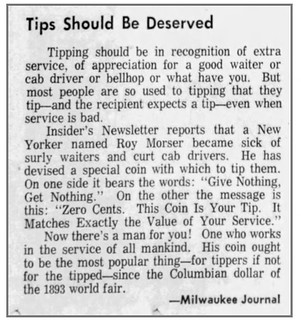
So we know Roy was a Public Relations person, and apparently a pretty good one. These were called "Kookie Koins". Can anyone fill in more of the backstory? Why exactly did he create these? Where were they made? Who owns the copyright today? Thanks. -Editor
To read a related earlier E-Sylum article, see:
NOTES FROM E-SYLUM READERS: OCTOBER 13, 2019 : Zero Cents Political Parody Coin
(https://www.coinbooks.org/v22/esylum_v22n41a11.html)

COINS FOUND ON OUTER BANKS BEACHES
Chris Neuzil passed along this article about a collection of coins found over the years along the beaches of the Outer Banks of North Carolina. Thanks! -Editor
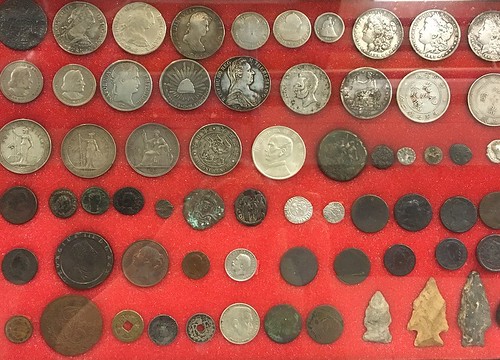
The William E. and Catherine F. Sell Coin Collection was donated to the Graveyard of the Atlantic Museum in Hatteras, North Carolina, in 2006. It includes 55 coins, the oldest of which date to 221-203 B.C. The newest, a five sucres coin from Ecuador, was minted in 1943.
The collection includes coins from China, Ecuador, England, France, Egypt, Germany, Greece, Italy, Mexico, Spain, and the United States. Even long-gone civilizations like the Byzantine Empire are represented in the historically significant treasure trove.
All that on the Outer Banks? Experts believe that the vast array of coins is likely tied to the number of shipwrecks off the state's coast.
"That doesn't necessarily mean that there were Greek and Roman sailors traversing the coast," an N.C. Maritime Museums spokesperson explained to Southern Living. "Instead, the oldest of the coins were conceivably scooped up with ballast from the bottom of harbors overseas and then washed ashore in North Carolina as ships broke up alongside the state's treacherous shoals."
There may also be some pirate loot in the haul.
"Since pirates would not have cared where a coin came from but would care about the material used to make them, the oldest silver coins could possibly have been carried here as 'treasure,'" the spokesperson added.
Coins are notoriously hard to display in a format that allows visitors to see detail, as well as both sides, clearly. As such, the collection is not currently on public display at the Graveyard of the Atlantic Museum.
The nonprofit museum is currently seeking funding to move forward with plans to create an exhibit that appropriately showcases the collection. That exhibit, as conceived, would include each coin displayed in a traditional case with a moveable magnifier to enlarge details. An accompanying electronic display would allow visitors to further explore each coin's history and significance.
Chris adds:
"The pre-European contact ones, like the ancients, are the ones that get me. The ballast idea doesn't really resonate, but I don't have a better one."
To read the complete article, see:
Exhibit Planned for Couple's Collection of Coins Found on Outer Banks Beaches Over the
Course of 70 Years (https://www.southernliving.com/news/outer-banks-rare-coin-collection-graveyard-of-the-atlantic-museum)

COLLECTING BRICKS
Think books are heavy? In the other-cool-things-people-collect department, here's an excerpt from a nice Atlas Obscura article about British collectors of bricks. -Editor
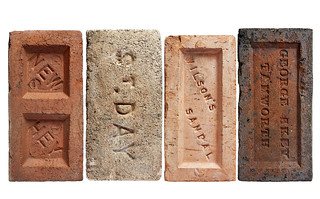 FOUR HUNDRED BRICKS LINE JASON Harris's hallway, and none of them hold the ceiling up. Arranged
in an earthy ombre from ruddy terra cotta to cream, these once-functional rectangles are now purely for show. The London-based architect doesn't think this hefty display lends him much gravitas in
British brick collecting circles, though. "I'm a lightweight brick collector because I just like the color and the shapes," Harris says. "I feel a little bit of a fraud amongst the collecting
community."
FOUR HUNDRED BRICKS LINE JASON Harris's hallway, and none of them hold the ceiling up. Arranged
in an earthy ombre from ruddy terra cotta to cream, these once-functional rectangles are now purely for show. The London-based architect doesn't think this hefty display lends him much gravitas in
British brick collecting circles, though. "I'm a lightweight brick collector because I just like the color and the shapes," Harris says. "I feel a little bit of a fraud amongst the collecting
community."
And he'd definitely be a fraud among builders, since his bricks all face the wrong way. Their frogs, the indentations on the top sides, are exposed to reveal writing that's usually hidden in a wall.
Frogs were first pressed into bricks in the late 18th century, to make for easier handling and allow room for extra mortar. A century later, manufacturers were stamping their names and addresses into the frogs, with lettering ranging from the primly functional to the wildly ornate. "It's design for utility that often has a strange, imperfect quality that really appeals," says Patrick Fry, a graphic designer who published a life-sized Brick Index book based on Harris's collection. "It holds an honest story."
These stories can only be read once old buildings are no longer standing. But as bricks loosen from the grips of Victorian homes, factories, and shops, their embossed frogs lure British brickophiles to stockpile them.
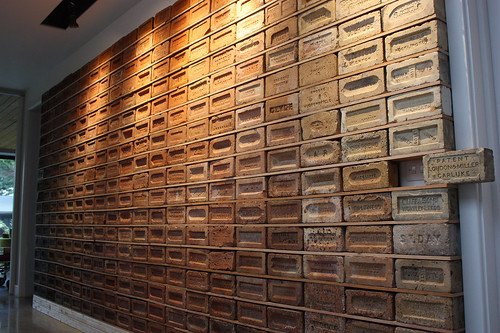
Henry and Mary Holt's collection of a whopping 7,000 bricks supposedly began after Henry saw a frog coincidentally inscribed with his last name: "E Holt and Company, Rossendale." A retired builder, Henry Holt might have missed the feel of a brick because he spent the next three decades (into the early 1990s) hunting for more, using outdated maps to pinpoint old brickworks and collieries. He'd then try to find the fruits of those brickworks at nearby demolition sites.
The Holt collection is legendary in groups like the British Brick Society, a club founded in 1974 by academics who wanted to study the history of brick building and brickmaking. Today its members are a mix of professionals and hobbyists, with a few in either camp collecting bricks. British Brick Society member John Harrison was interested in brickwork history first. "I am not a collector who chose to collect bricks," explains Harrison. "I am someone with an interest in brickwork and bricks who ended up collecting some."
To read the complete article, see:
Inside the World of British Brickophiles (https://www.atlasobscura.com/articles/brick-collecting/)

LOOSE CHANGE: JANUARY 10, 2021
Here are some additional items in the media this week that may be of interest. -Editor
Beloit Coin Shops
Here's a nice article about local coin shops from Wisconsin's Beloit Daily News . -Editor
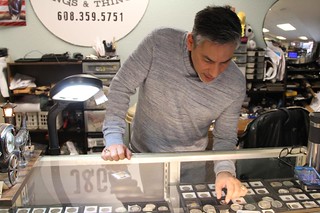 John Galvan, co-owner of J&G's Coins, Rings & Things with wife Gaia Galvan, started
collecting coins as a hobby when he was a kid living in Chicago, and his passion grew from there.
John Galvan, co-owner of J&G's Coins, Rings & Things with wife Gaia Galvan, started
collecting coins as a hobby when he was a kid living in Chicago, and his passion grew from there.
"A lot of collectors start our interested in specific types of coins, certain eras, mint errors, and so forth," John Galvan said. "To me, as a kid, I would go through coins and I would want to collect them all. They are fun."
"I never knew I would have a shop," John Galvan said. "We needed a place with security after I was doing some pretty large transactions. We never thought it would explode like this."
He said no coin collector he sees at his shop is the same.
"Everyone has their niche," John Galvan said.
Ben Kasberger, owner of L&B Coins & Collectibles in South Beloit, said he was exposed to coin collecting as a kid through his late father Larry Kasberger.
"My dad would tell me stories about how he grew up in Marshfield and they would go into town and he'd go to the bank and sort through coins," Kasberger said of his father, who passed away in May of 2017.
Kasberger said working at L&B was "like a treasure hunt every day."
To read the complete article, see:
Coin
collecting a 'modern day treasure hunt' for some, way of investing for others
(https://www.beloitdailynews.com/news/local-news/coin-collecting-a-modern-day-treasure-hunt-for-some-way-of-investing-for-others/article_fe3cbb4f-c405-55b8-b976-ab9246fec130.html)
Other topics this week include the ANS Brasher Doubloon, and coins for Mars. -Editor
The ANS Brasher Doubloon
Last week we discussed two Brasher Doubloons offered by Heritage. Here's a video from the American Numismatic Society about their specimen. -Editor
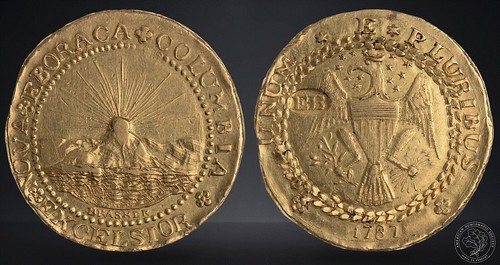
To watch the video, see:
The ANS's Greatest Coins: the Brasher Doubloon. An extremely interesting and valuable rare coin.
(https://www.youtube.com/watch?v=MVeJREpJhGk&feature=youtu.be)
To read the earlier E-Sylum article, see:
HERITAGE OFFERS PARTRICK BRASHER DOUBLOONS (https://www.coinbooks.org/v24/esylum_v24n01a20.html)
Tenino Scammed Out of $270,000
In the I-think-we'd-better-print-more-wooden-money department, the city of Tenino, WA has found itself short over a quarter of a million dollars. -Editor
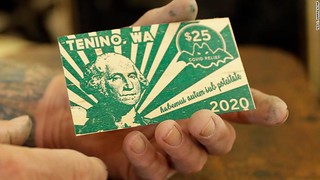 Fraudsters scammed the city of Tenino out of $270,000 last year, wiring the money to Houston
and then overseas. According to Mayor Wayne Fournier, the city agreed to loan $23,000 to what they thought was the Washington Municipal Clerks Association in order to pay for some expenses for their
50th anniversary celebration.
Fraudsters scammed the city of Tenino out of $270,000 last year, wiring the money to Houston
and then overseas. According to Mayor Wayne Fournier, the city agreed to loan $23,000 to what they thought was the Washington Municipal Clerks Association in order to pay for some expenses for their
50th anniversary celebration.
"It was unusual, but it was presented to us by the staff member as something that's typical," Fournier said. "It was a very small ask and really didn't even pop up on the radar of city council or myself."
How that $23,000 ballooned to more than 10 times that amount? That's where Fournier says things get fuzzy.
"I don't have an answer to that. That's where things go awry," he said. "So exactly how it occurred is still trying to be understood."
To read the complete article, see:
City of Tenino Scammed Out of $270,000
(http://www.chronline.com/news/city-of-tenino-scammed-out-of-270-000/article_0a657a8e-521b-11eb-898e-5f4aa5dded27.html)
To read earlier E-Sylum articles, see:
CNN COVERS TENINO'S 2020 WOODEN MONEY (https://www.coinbooks.org/v23/esylum_v23n25a31.html)
MORE ON THE 2020 TENINO WOODEN SCRIP (https://www.coinbooks.org/v23/esylum_v23n29a29.html)
Musk's "Marscoin"
We haven't set foot on the Red Planet yet, but some folks are already speculating on what we'll use for money when we get there. Found via News & Notes from the Society of Paper Money Collectors (Volume VI, Number 28, December 29, 2020). -Editor
Elon Musk's internet corner is abuzz again after Musk agreed that any settlements he makes on Mars will be powered by cryptocurrency like "dogecoin" or, as Musk endorsed on Twitter, "Marscoin."
What would cryptocurrency mean for people living on Mars? And is there even a traditional currency for the Mars settlers to try to use?
Cryptocurrency has some major advantages. The idea of Mars settlers having virtual accounts rather than any kind of paper currency based on Earth standards makes sense—not only is it impractical to lug cash to Mars, but it's also hard to imagine a reasonable way for any of those transactions to be reconciled. Travelers will likely have dedicated accounts that work both on the long trip to Mars and on the planet's surface.
Could transactions be sent back and forth to Earth? That part is actually relatively simple. Batches of transactions could make it to Earth in up to about 20 minutes at most if they were transmitted using radio waves.
To read the complete article, see:
Elon Musk Says Mars Settlers Will Use Cryptocurrency, Like
'Marscoin' (https://www.popularmechanics.com/space/moon-mars/a35085273/elon-musk-says-mars-settlers-will-use-cryptocurrency-like-marscoin/)
FEATURED WEB SITE: APOTHECARIES WEIGHTS
This week's Featured Web Site is about Apothecaries Weights.
Apothecaries Weights were the weights which Pharmaceutical Chemists (Pharmacists) used exclusively until the late 1960's.
The writer commenced his career in Pharmacy at the beginning of 1949 and used these weights on a daily basis for almost the next twenty years until they were replaced by metric weights.

